#elle st. pierre
Explore tagged Tumblr posts
Text
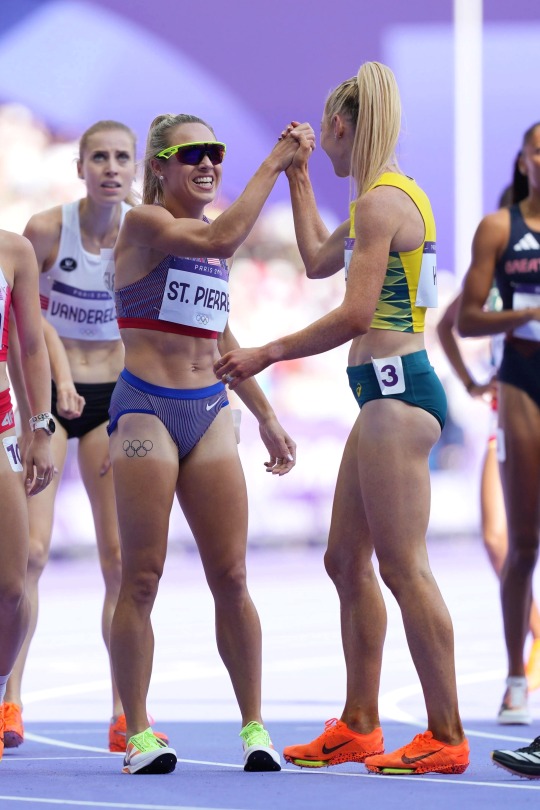
Elle St. Pierre 🇺🇸 and Jessica Hull 🇦🇺
Paris 2024 Olympics
#elle st. pierre#jessica hull#team usa#team australia#female athletes#running#runners#olympic athletes#shaking hands#athletics#track and field#paris 2024#olympics
84 notes
·
View notes
Text
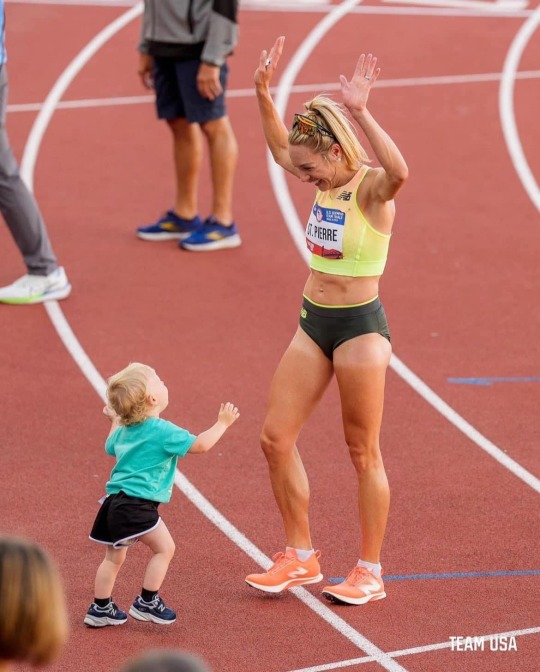
Elle Purrier St. Pierre | Team USA
#elle purrier st pierre#running#sports#family#kids#olympics#paris 2024#team usa#uotd#whitefireprincess
15 notes
·
View notes
Text
THE WHITEWASHING OF MAMAN BRIGITTE
Why it is problematic to portray Maman Brigitte (Grann Brijitte) as a white woman
Companion piece to: https://the-girl-who-didnt-smile.tumblr.com/post/761617414938148864/baron-samedi-vs-papa-guede
Disclaimer: I have no ancestral ties to Haiti. I am half White and not Black. The following is merely an opinion piece, which I have attempted to support with evidence.
If you have ever attempted to research New Orleans Voodoo, you’ve probably encountered descriptions of Maman Brigitte like so:
In Voodoo, Ma'man Brigit (Grann Brigitte, Manman, Manman Brigit, Manman Brijit) is the mother of cemeteries, the loa of money and death, and the wife of Baron Samedi. She may be related to the "triple" Celtic goddess of poetry, smithcraft, and healing, Brigid/St. Brigit, as her name is Irish in origin. She is usually depicted as a white woman.
The above is inaccurate.
Traditionally, Haitian artists depict Maman Brigitte as a Black woman, where she is not white, biracial, or lighter skinned than Baron Samedi.
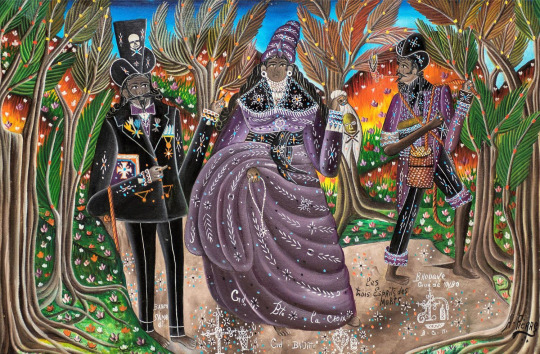
Baron Samedi, Grande Brigitte, and Guede Nibo, as portrayed by Andre Pierre.
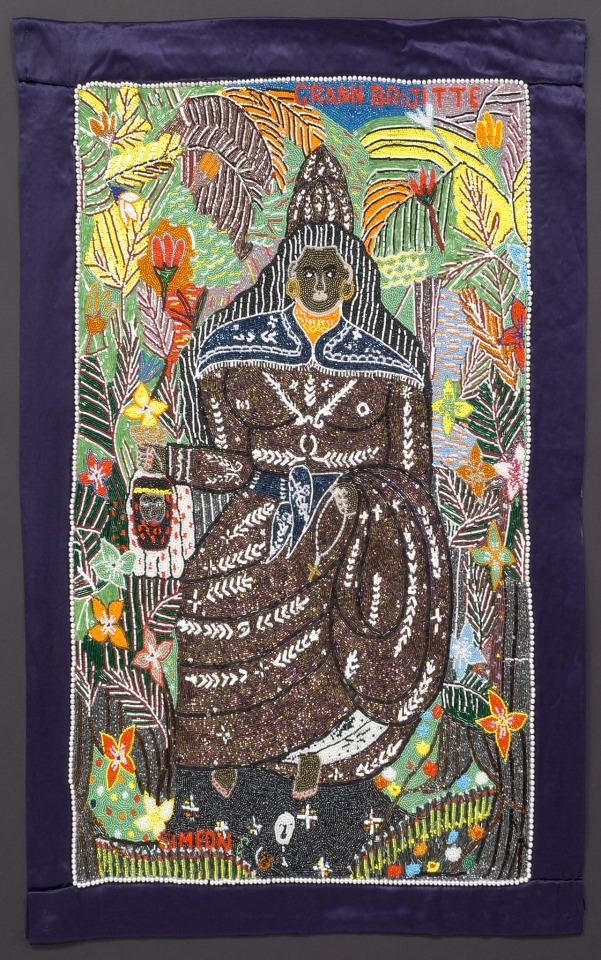
Grann Brijitte, as portrayed by Amina Simeon.

Baron Samedi and Maman Brigitte, as portrayed by Gerard Paul.

Grann Brijit, as portrayed by Roudy Azor.
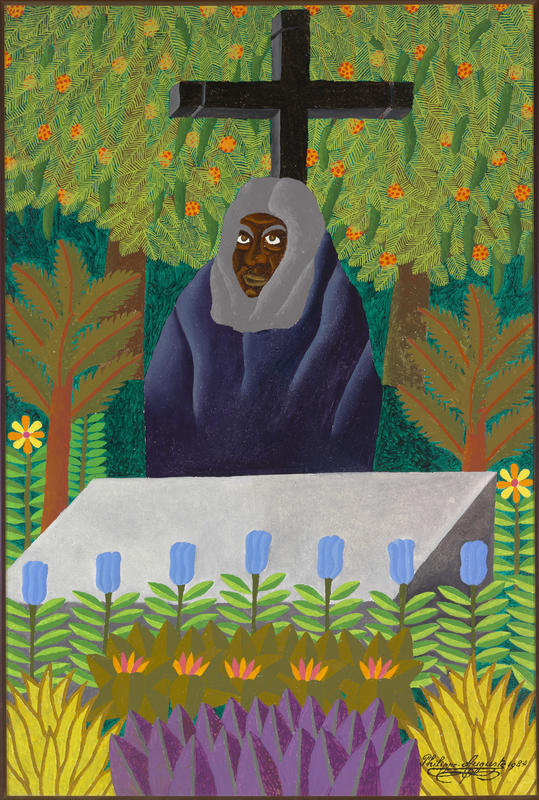
Grann Brijit, as portrayed by Salnave Philippe-Auguste.
In Mythologie Vodou Vol. 2 (1950), Milo Marcelin includes a two-page description of Maman Brigitte (Grande Brijitte). The first paragraph of this section reads as follows:
Grande Brijitte, femme de Baron-Samedi et mère des Guédé, est une négresse très vieille —c’est pourquoi on l’appelle grande (grand' mère). Elle est identifiée à Sainte Brigitte, patronne de l’Irlande; elle a pour reposoir un «cirouellier» (spondias purpurea L.) ou un figuier maudit marron (clusia rosea Jacq.) et, parfois, dans les cimetières, un amoncellement de pierres la représente. Ses jours sont le lundi et vendredi, sa couleur, le noir.
English Translation:
Grande Brijitte, wife of Baron-Samedi and mother of the Gede, is a very old Black woman – this is why she is called “grande” (grandmother). She is identified with Saint Brigid, patron saint of Ireland; she has as her resting place a “cironelle” (spondias purpurea L.) or an autograph tree (clusia rosea Jacq.) and, sometimes, in the cemeteries, a pile of black stones represents her. Her days are Monday and Friday, her color, black.
The full excerpt from Mythologie Vodou, Vol. II is found on pages 177-178, and included at the bottom of this article, in APPENDIX A.
Where does the notion of a white Maman Brigitte come from?
In “Gran Brijit: Haitian Vodou Guardian of the Cemetery” (2010), Kerry Noonan proposes a theory that Gran Brijit is derived from the Irish Saint Brigitte. Initially, I described this article as a “helpful overview”; I no longer agree with this statement. While Noonan’s article does contain some helpful information, many of the connections she makes are poorly argued—including connections to Saint Brigitte, the orisa Oya, and Sheela na gig.
Noonan asserts that Maman Brigitte is identified with Saint Brigitte because of the influence of “Irish settlers and sailors and Breton priests". In one of the most objectionable sections of this article, Noonan characterizes the “Irish settlers” as “indentured servants”.
As indentured servants, Irish and Scottish people were sent to territories under the control of the British Empire. The British West Indies did not include present-day Haiti. Presumably, Noonan is referring to fugitive indentured servants, called “ingleses”. In “Irish Indentured Servants, Papists and Colonists in Spanish Colonial Puerto Rico” (2007), Jorge L. Chinea claims that “Puerto Rico, Hispaniola and Cuba became popular destinations for the fugitives.” Chinea also describes how the Spanish repeatedly denied the Irish authorization to settle in Hispaniola during the late 1600s: “In this instance, their potential infringement on the Spanish American trade in a colony already heavily involved in contraband was a major reason for turning them down.”
Nowhere does Noonan mention the influence of Irish slave owners.
"The many Haitians and West Indians who trace their ancestry back to Africans transported on Irish-owned slave ships are living proof that the Irish have not always been the victims of history."
– Joe O’Shea (2012) “The Irish have not always been the victims of history”:
In “Irishness, Whiteness, Blackness, and Slavery in the Early Modern World” (2022), Jane Ohlmeyer describes how the Irish contributed to “one of the harshest systems of servitude in western history” during the 18th century:
“Of the 550 families involved in the French slave trade, seventeen had Irish surnames. One of the most successful Irish slavers was Antoine Walsh, the son of an Irish merchant who had settled in France in the later seventeenth century and married Marie O’Sheil/Shiell, whose grandfather had settled in France. Over the course of his career Walsh made forty slaving trips from Nantes and shipped more than 12,000 enslaved Africans. With his profits Walsh purchased a plantation for himself in the French colony of Saint-Domingue (modern day Haiti), which supplied up to seventy percent of all of the sugar sent to France.”
It may be due to the presence of these slave owners that Haitian women with the name “Brigitte” appear in the historical record.
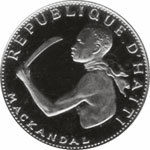
Pictured: François Mackandal, whose wife was named Brigitte
Rather than Saint Brigitte or the Celtic goddess Brigid, a likelier candidate for the origin of Maman Brigitte is the wife of the famous Haitian maroon leader François Mackandal, who was named Brigitte Mackandal.
This theory was proposed by Crystal Nicole Eddins’ (2022) Rituals, Runaways, and the Haitian Revolution:
“Mackandal’s wife, Brigitte, may have transitioned into the world of the lwa as Maman Brigitte, who has authority over cemeteries.” (p. 122)
SOURCE: Eddins, Crystal Nicole. Rituals, Runaways, and the Haitian Revolution: Collective Action in the African Diaspora. United Kingdom, Cambridge University Press, 2022. https://doi.org/10.1017/9781009256148 Retrieved from: https://www.cambridge.org/core/books/rituals-runaways-and-the-haitian-revolution/2FCBF92A767FD8DE3615602F589C326E#overview
John D. Garrigus mentions Brigitte Mackandal in A Secret among the Blacks (2023), describing her in the following terms:
“...Brigitte, described as Makandal’s wife and a ritual leader in her own right, claimed that a makandal bundle “consulted by its servant” could reveal the location of “an escaped slave, who had stolen something that was missing, the poisoner, and other [things]...” (p. 78)
SOURCE: Garrigus, John D.. A Secret Among the Blacks: Slave Resistance Before the Haitian Revolution. United States, Harvard University Press, 2023. https://www.hup.harvard.edu/books/9780674272828
Garrigus refers to three primary sources that mention Brigitte Mackandal:
1. Sébastien Jacques Courtin’s (1758) “Mémoire Sommaire Sur Les Prétendus Pratiques Magiques et Empoisonnements…”
2. Charles Fournier de la Chapelle (1758) “Mémoire pour servir à l’information des procés contre les négres devins, sorciers et empoisonneurs”
3. Michel-René Hilliard d’Auberteuil, “Considérations sur l’état présent de la colonie française de Saint-Domingue” (Paris: Grangé, 1776), 1:137.
I have attempted to transcribe excerpts from these historical texts, which can be viewed here: https://archiveofourown.org/works/54861145/chapters/156619222
Commenting further on Brigitte Mackandal, Eddins writes:
“Women like Brigitte Mackandal and Marie Catherine Kingué demonstrated the “radical implications of black women’s spiritual politics” by embracing acts of “woman-centered preservation,” such as poison, healing, and midwifery, that fundamentally opposed racial capitalist exploitation of black women’s bodies.” (p. 144)
SOURCE: Eddins, Crystal Nicole. Rituals, Runaways, and the Haitian Revolution: Collective Action in the African Diaspora. United Kingdom, Cambridge University Press, 2022. https://doi.org/10.1017/9781009256148 Retrieved from: https://www.cambridge.org/core/books/rituals-runaways-and-the-haitian-revolution/2FCBF92A767FD8DE3615602F589C326E#overview
Even if there is no connection between Maman Brigitte and Brigitte Mackandal, these documents demonstrate that there existed Haitian women from this time period with the name “Brigitte”. These women might have been named after Saint Brigitte because there were a number of slave owners of Irish descent, such as Antoine Walsh, and possibly from the Celtic province of France (Brittany). The Gede rite, to which Maman Brigitte belongs, contains the spirits of Haitian ancestors. This would explain why Maman Brigitte is not a white woman, but an old Black woman–she is an important ancestral spirit of a Haitian woman named “Brigitte” who lived several hundred years ago.
Of the Haitian women named “Brigitte”, Brigitte Mackandal is a strong candidate due to her leadership role and historical importance. François Mackandal is a very important figure from Haitian history, described as the precursor to the Haitian Revolution. As Brigitte Mackandal seems to have also been a leader among the slaves, it is plausible that her spirit became the lwa Maman Brigitte.
In Haitian Vodou, Catholic Saints can come to be identified with important ancestral spirits, like so:
“KB: Tell me everyone who "walks with Dantò," everyone who you have here on your altar with Dantò.”
“ML: You have St. Rose of Lima; she is a Petwo. You have St. Philomène. She is Petwo. She is a lwa too, Manbo Philomise. You see St. Andrew? You see Sacred Heart–who walks with Simbi? And then you have St. Jude. He is a Legba Petwo, too.”
“Spirits who have been important to one of the ancestors occupy a dual role in Vodou, one in which they are treated as both spirits and ancestors. So when Mama Lola serves St. Philomène, she also honors the spirit of her mother, Philomise, a well-known healer in Port-au-Prince. It is because of this that the altars can be seen as repositories of family history, or, more literally, as repositories of the family itself.”
SOURCE: Lola, Mama & Brown, Karen McCarthy. "The Altar Room: A Dialogue." In Cosentino, Donald. Sacred Arts of Haitian Vodou. United States, UCLA Fowler Museum of Cultural History, 1995. p. 229-230. Retrieved from: https://archive.org/details/sacredartsofhait0000unse/page/228/mode/2up?
Maman Brigitte probably came to be identified with Saint Brigitte because of the Breton priests that were sent to Catholicize Haiti.
In “Rev. John J. Burke, the National Catholic Welfare Conference, and the American Occupation of Haiti” (2014) Donald J. Slawson describes how Roman Catholicism was brought to Haiti:
“The concordat between the Vatican and Haiti dated to 1860. From the time of Haitian independence in 1804 until that year, the condition of the Catholic Church in that country was deplorable…As early as 1834, Rome and Port-au-Prince had entered into negotiations to regularize the status of the Church in Haiti. President Fabre Geffrard finally achieved that goal…Given the nation’s colonial and cultural ties with France, the bishops and clergy came from Brittany.”
Noonan describes the importance of Saint Brigid to Breton priests: "Catholics in both Ireland and Brittany are devoted to the Irish St. Brigit of Kildare, and many churches are dedicated to her in both areas."
According to Sidney Mintz & Michel-Rolph Trouillot's "The Social History of Haitian Vodou", many features of modern Vodou took shape in the century that followed the Haitian Revolution. During this time period, Roman Catholics were sent to Haiti for the purpose of religious imperialism. They were openly hostile toward vodouisants, and sought to destroy African-based traditions.
This attitude persisted into the 20th century, as described by Melville Herskovits in Life in a Haitian valley (1964):
“The attitude of the Church toward vodun is one of intransigent hostility. The anger with which the priest preached his sermon on the Sunday morning following a vodun dance held close enough to town so that the sound of the drums, plainly audible, "disturbed" him the night long, clearly indicates how deeply the priests of the Church resent the worship of the African gods. In Mirebalais they tell how, at the instance of the Church, vodun rites were unmercifully suppressed by the Americans during the occupation, to whom it was represented as a potential focus for revolt. In the place huge bonfires were made of vodun drums painted and "dressed" in elaborate manner. Everything found in the humforts and the private houses of worship was confiscated, and the "thunder stones," necklaces of the devotees, and other sacred objects that would not burn were thrown into the Artibonite River. Today the Church takes full advantage of its status as the only recognized religious organization in Haiti to dictate the official position of government toward vodun.”
Long story short, it is most likely that the important ancestral lwa Maman Brigitte originates in a Haitian woman who was named “Brigitte” – possibly, Brigitte Mackandal.
The narrative that connects Maman Brigitte to indentured servants is a fiction invented by white people.
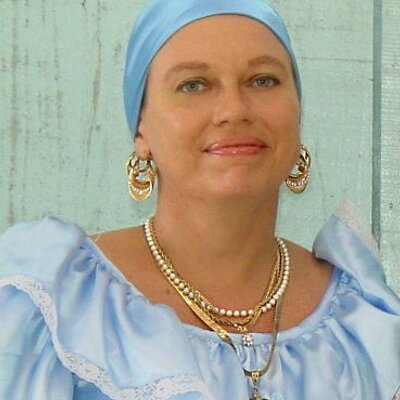
Pictured: Mambo Racine
“Maman Brigitte, the Mother of the Gedes” is a Google Groups conversation on alt.religion.orisha, dated Jun 16, 2001 - Jun 19, 2001. In this conversation, which may have only involved white people, there is an exchange between Mambo Racine and Kenaz Filan (at the time, named Kevin Filan).
The full conversation is included in APPENDIX B. The top post is the most relevant one:

Maman Brigitte is a manifestation of the Celtic Goddess Brigid. During the formative period of Haitian Vodou, many Scottish people were deported from Scotland to the Antilles because of the Stuart wars, and those Scots were the most traditionalist, the least Christianized. They were the ones who brought Brigid to Haiti.
During this time, blacks outnumbered whites about 4000 to one. This is a literal fact. So it is unlikely that those few whites could prevent Africans from having drum dances - it seems to me more likely that an uneasy truce obtained, you know, the whites said in effect, "Do your work and I will leave you alone."
At that time the whites most likely to participate in drum dances were of course the poor whites, not the few French elite whites. And among them, the most likely people to participate were the women - just the folks most likely to have preserved the service of Brigid.
(Before I go any further let me suggest that anyone who hasn't read Jayelle's "White Women in Vodou" do so!)
Now, the first woman buried in any cemetary is by definition Brigid, and the first man buried in any cemetary is by definition Baron. Of course when those drum-dancing poor Scottish women died they were buried in the same earth as Africans, and the agglomerative, pragmatic nature of Vodou as it developed would of course naturally incorporate Brigid, and metamorphose her into Maman Brigitte.
Now, to make Gede lwa, Maman Brigitte and Baron La Croix take souls from "under the water" and rebaptize them. That is why all Gede lwa have the last name La Croix, because their father is Baron La Croix. This is a real birth, out of the waters, Baron and Brigitte are not "adoptive parents", they are as much parents as any parent can be.
For more information on the travels of one Gede lwa, see "Biography of a Lwa" under the Special Topics heading on The VODOU Page. And for more information on ancestral lwa in general, see Vodou Lesson 2 under the Vodou Lesson heading on The VODOU Page.
Peace and love,
Bon Mambo Racine Sans Bout Sa Te La Daginen
"Se bon ki ra" - Good is rare Haitian Proverb
The VODOU Page - http://members.aol.com/racine125/index.html
It goes without saying, this is not well-researched.
This is how Maman Brigitte became something of a “patron saint” for white people involving themselves in Vodou, at the expense of Black women.
It feels childish that I even have to say this, but I don’t want anyone to send this woman hate. I don’t think it is fair to rake someone over the coals for saying something stupid over 20 years ago. Additionally, it would be unfair to pin the blame on this one person, as she is not necessarily the originator and it was clearly a group of people who believed this. Rather, it is important to learn from past mistakes by examining the cause and effect.
This false narrative didn’t stay confined to a small group of people. It spread into publications, which are now sitting in libraries and websites all over the internet.
Recall the description I included at the beginning:
In Voodoo, Ma'man Brigit (Grann Brigitte, Manman, Manman Brigit, Manman Brijit) is the mother of cemeteries, the loa of money and death, and the wife of Baron Samedi. She may be related to the "triple" Celtic goddess of poetry, smithcraft, and healing, Brigid/St. Brigit, as her name is Irish in origin. She is usually depicted as a white woman.
This is an excerpt from Denise Alvarado’s (2009) The Voodoo Hoodoo Spellbook. This is one of several popular books that mischaracterizes Maman Brigitte in this manner. Artists, authors, and other creators read these books, which informs their character designs.
See how Maman Brigitte is typically portrayed in popular media:
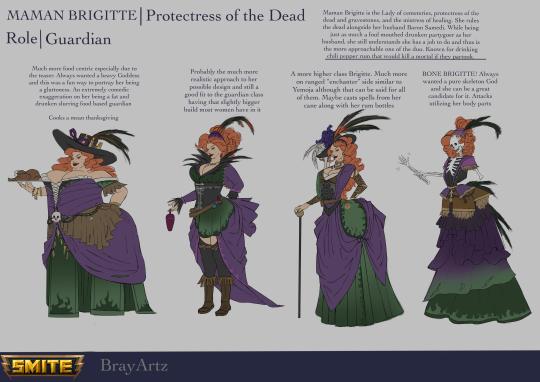

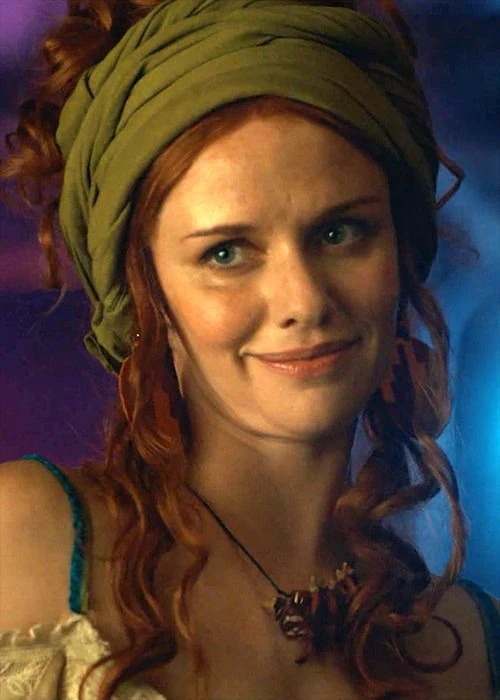
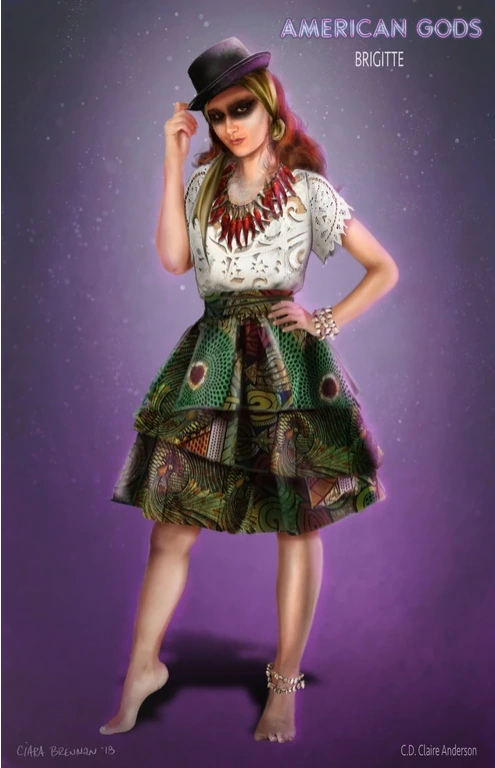
This is not the fault of this actress, at all. American Gods was actually praised for its portrayal of African spiritualities! At least, by some people… There could be intense internet discourse about how bad this portrayal was, which I am not privy to because I don’t use Twitter…
I genuinely think the creative team behind American Gods (and possibly Smite…I wouldn’t know because I don’t play…) made a serious attempt to research New Orleans Voodoo. It is not because they didn’t care or try to research this topic; rather, it speaks to how widespread and deep-rooted this problem is.
This matters because it contributes to colorism and racism against women. All across popular media, dark-skinned Black women are denigrated and erased, which impacts how people see and treat Black women in real life. Whenever they do appear, they are often stereotyped and/or excessively criticized by audiences, who can’t be normal around a “twofer minority”. This pattern has been the norm for most of human history. It went uncriticized until very recently, and continues into the present day.
More to the point, the lwa are sacred to Vodouisants of Haitian heritage. Haiti Vodou is embedded in the history of Haiti – the first nation to permanently ban slavery. This was won through a bloody Revolution, which is why the lwa are these warrior-like spirits of justice. The whitewashing of religious figures is disgraceful–especially the lwa of Haiti.
There are regional differences in Haitian Vodou, which is why accounts from different, credible sources can vary. Unfortunately, this is used as an excuse to invent falsehoods about the lwa. It is inaccurate to describe Maman Brigitte as a mere manifestation of the European saint or goddess. Instead of viewing her as European or African in origin, Maman Brigitte is best described as a lwa that is uniquely indigenous to Haiti–probably, the spirit of an important Haitian ancestor who was named “Brigitte”.
Haitian Vodou is a part of Haitian national heritage, and the lwa are ancestral to the Haitian people. We should respect the depiction of Maman Brigitte as she is portrayed by Haitians.
She is not this:

But this:
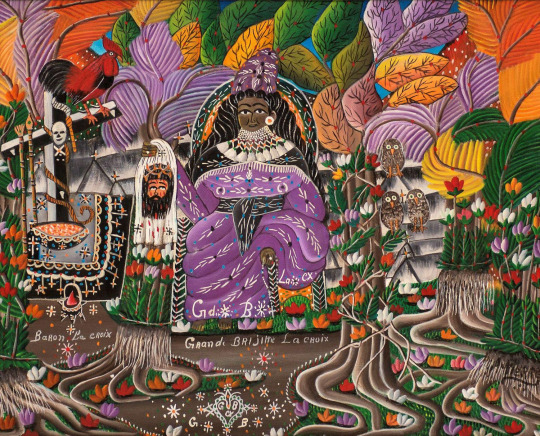
CITATION LIST:
Alvarado, Denise. Voodoo hoodoo spellbook. Weiser Books, 2011: p. 34.
Chinea, Jorge L. "Irish Indentured Servants, Papists and Colonists in Spanish Colonial Puerto Rico, ca. 1650-1800." Irish Migration Studies in Latin America 5.3 (2007): pp. 171-81. https://www.irlandeses.org/0711.pdf#page=35
Desmangles, Leslie Gerald. “African Interpretations of the Christian Cross in Vodun.” Sociological Analysis, vol. 38, no. 1, 1977, pp. 13–24. JSTOR, https://doi.org/10.2307/3709833. Accessed 9 Sept. 2024.
Hebblethwaite, Benjamin. A Transatlantic History of Haitian Vodou: Rasin Figuier, Rasin Bwa Kayiman, and the Rada and Gede Rites. United States, University Press of Mississippi, 2021. p. 204
Herskovits, Melville J.. Life in a Haitian Valley. United States, Octagon Books, 1964: pp. 289-290. https://archive.org/details/lifeinhaitianval0000hers/page/288/mode/2up
Marcelin, Milo. "Mythologie vodou (Rite Arada), Volume II." Pétionville: Éditions Canapé Vert (1950). pp. 177-178
Mintz, Sidney & Trouillot, Michel-Rolph. “The Social History of Haitian Vodou”. In Cosentino, Donald. Sacred Arts of Haitian Vodou. United States, UCLA Fowler Museum of Cultural History, 1995: pp. 123-147. https://ghettobiennale.org/files/Trouillot_Mintz_LOW.pdf
Noonan, Kerry. “Gran Brijit: Haitian Vodou Guardian of the Cemetery.” In Goddesses in World Culture: Volume 3, Australia and the Americas, edited by Patricia Monoghan, 123-133. Denver, Colorado: Praeger, 2011
Ohlmeyer, Jane. “Irishness, Whiteness, Blackness, and Slavery in the Early Modern World.” American Journal of Irish Studies, vol. 17, 2022, pp. 5–38. JSTOR, https://www.jstor.org/stable/27290673. Accessed 9 Sept. 2024.
Slawson, Douglas J. “Rev. John J. Burke, the National Catholic Welfare Conference, and the American Occupation of Haiti (1915-34).” The Catholic Historical Review, vol. 100, no. 3, 2014, pp. 514–54. JSTOR, http://www.jstor.org/stable/43898675. Accessed 9 Sept. 2024.
APPENDIX A: FULL EXCERPT FROM MILO MARCELIN’S (1950) MYTHOLOGIE VODOU VOL. 2:
GRANDE BRIJITTE
Grande Brijitte, femme de Baron-Samedi et mère des Guédé, est une négresse très vieille —c’est pourquoi on l’appelle grande (grand' mère). Elle est identifiée à Sainte Brigitte, patronne de l’Irlande; elle a pour reposoir un «cirouellier» (spondias purpurea L.) ou un figuier maudit marron (clusia rosea Jacq.) et, parfois, dans les cimetières, un amoncellement de pierres la représente. Ses jours sont le lundi et vendredi, sa couleur, le noir.
Grande Brijitte est aussi puissante que son mari. Parfois elle préside au cimetière. Si la première personne enterrée dans un cimetière nouvellement construit est un homme, on dit qu'il est Baron-Samedi et il est le maître de ce cimetière; si c’est une femme, elle est Grande Brijitte et elle est maîtresse de ce cimetière.
Les cas de possessions de Grande Brijitte sont fort rares. Quand elle possède une personne, celle-ci est comme morte. On lui bande la mâchoire avec un foulard noir, on lui met du coton aux oreilles et aux narines, on la couvre d'un drap blanc, on l'asperge de clairin (rhum blanc) et on chante:
Ou dit Manman Brijitte couché,
L’ap’ dômi!
Ou dit Manman Brijitte couché,
L’ap’ dômi!
Lô-r la réveillé,
Dèniè hounsi dô-bas!
D'leau lan gé Manman Brijitte!
Lô-r la réveillé
Dèniè hounsi dô-bas!
Tu dis que Maman Brijitte est couchée,— Et qu'elle dort! — Tu dis que Maman Brijitte est couchée, — Et qu'elle dort! — Quand elle se réveillera,— Toutes les hounsis (serviteurs du temple) seront dos bas! — Il y a de l'eau dans les yeux de Maman Brijitte! — Lors-qu’elle se réveillera, — Toutes les hounsis seront dos bas!
Grande Brijitte ne parle jamais. Quand elle se retire de son cheval (de sa possédée), on chante parfois cette chanson:
Manman Brijitte alé
Guingue, gongue!
Manman Brijitte alé
Guingue, gongue!
Manman Brijitte est partie – Guingue, gongue (tintement de la cloche: le glas funèbre!) – Maman Brijitte est partie – Guingue, gongue!
Parfois Grande Brijitte et Baron-Samedi apparaissent ensemble. On revêt ce dernier d'un linceul, on lui met aussi du coton aux oreilles et aux narines. Il s'assied sur le lit où est étendue sa femme. Lui non plus ne parle pas, ne boit pas, ne fume pas. On les veille alors, comme on fait pour les morts.
Une invocation à Grande Brijitte:
Brave, oh!
Alé rhélé Manzè Brijitte pou mouin!
M’ prall’ Thomazeau!
M’ pa gaingnin Manman,
Qui pou palé pou mouin!
M’ pa gaingnin Papa,
Qui pou palé pou mouin!
Brave, oh!
Alé rhélé Manzè Brijitte pou mouin!
M’ prall’ Thomazeau!
Brave (Guédé), oh! — Va appeler Mam'zelle Brigitte pour moi! — Je vais à Thomazeau (ville du Département de l’Ouest)! — Je n’ai pas de Maman, — Pour prendre ma défense! — Je n’ai pas de Papa, — Pour prendre ma défense! — Brave, oh!— Va chercher Mam’zelle Brijitte pour moi! — Je vais à Thomazeau!
Le menu rite du repas de Grande Brijitte est composé de patates, de bananes (plantain), du hareng-sel et de la morue boucanés, du maïs et des pistaches grillés, du gros-sirop (sirop de canne à sucre). On lui offre du clairin (rhum blanc) et en sacrifice, des poules noires.
APPENDIX B: “Maman Brigitte, the Mother of the Gedes”
Racine125
Jun 16, 2001, 4:37:00 PM
to
Maman Brigitte is a manifestation of the Celtic Goddess Brigid. During the
formative period of Haitian Vodou, many Scottish people were deported from
Scotland to the Antilles because of the Stuart wars, and those Scots were the
most traditionalist, the least Christianized. They were the ones who brought
Brigid to Haiti.
During this time, blacks outnumbered whites about 4000 to one. This is a literal fact. So it is unlikely that those few whites could prevent Africans from having drum dances - it seems to me more likely that an uneasy truce obtained, you know, the whites said in effect, "Do your work and I will leave you alone."
At that time the whites most likely to participate in drum dances were of course the poor whites, not the few French elite whites. And among them, the most likely people to participate were the women - just the folks most likely to have preserved the service of Brigid.
(Before I go any further let me suggest that anyone who hasn't read Jayelle's "White Women in Vodou" do so!)
Now, the first woman buried in any cemetary is by definition Brigid, and the first man buried in any cemetary is by definition Baron. Of course when those drum-dancing poor Scottish women died they were buried in the same earth as Africans, and the agglomerative, pragmatic nature of Vodou as it developed would of course naturally incorporate Brigid, and metamorphose her into Maman Brigitte.
Now, to make Gede lwa, Maman Brigitte and Baron La Croix take souls from "under the water" and rebaptize them. That is why all Gede lwa have the last name La Croix, because their father is Baron La Croix. This is a real birth, out of the waters, Baron and Brigitte are not "adoptive parents", they are as much parents as any parent can be.
For more information on the travels of one Gede lwa, see "Biography of a Lwa" under the Special Topics heading on The VODOU Page. And for more information on ancestral lwa in general, see Vodou Lesson 2 under the Vodou Lesson heading on The VODOU Page.
Peace and love,
Bon Mambo Racine Sans Bout Sa Te La Daginen
"Se bon ki ra" - Good is rare Haitian Proverb
The VODOU Page - http://members.aol.com/racine125/index.html
Kevin Filan
Jun 17, 2001, 3:43:50 PM
to
Thanks for a fascinating essay on Maman Brigitte. While I can't comment
on her place in Haitian Vodou, I do have some knowledge of Scots and
British history, as well as a bit of experience doing scholarly
research. While I think you make a couple of questionable assertions,
you also have raised some interesting points.
Racine125 wrote: > > Maman Brigitte is a manifestation of the Celtic Goddess Brigid. During the > formative period of Haitian Vodou, many Scottish people were deported from > Scotland to the Antilles because of the Stuart wars, and those Scots were the > most traditionalist, the least Christianized. They were the ones who brought > Brigid to Haiti.
http://www.learner.org/biographyofamerica/prog13/feature/index_text.html
Tells us the first African slaves in the New World arrived in Hispaniola in 1501... and the first slave rebellion in Hispaniola was in 1522. By that time Scotland had been Christian for over a thousand years. While Neopagans love to speculate about isolated villages practicing "the Olde Pagan Customs" well into the 20th century, I've yet to see any evidence of same. I certainly doubt VERY strongly that there were any Scotsmen of that time, no matter how isolated a little town they came from, who would have considered themselves "Brigid worshippers." I'm even inclined to think that by the time of the Stuart Wars poor White indentured servants were largely becoming a thing of the past, as the Slave routes became well-established and the full horror of that machinery was coming into operation. There were certainly Catholic Scots who got the heck outta Dodge during the Stuart Wars: many of them wound up in Catholic France or some of the French colonies. But I'm not sure that they came to St. Dominique as indentured servants.
Here's an excerpt from http://www.scotlandspast.com/religion.htm which shows that Christianity was well established in Scotland by the 8th century: the whole site, BTW, is fascinating and well worth a read.
* * * * *
The first named missionary to Scotland is Ninian who is referred to in an aside by Bede while discussing the conversion of the Picts in his Ecclesiastical History of the English People written in 731 AD. In this aside he says 'The southern Picts, who live on this side of the mountains, are said to have abandoned the errors of idolatry long before this date and accepted the true Faith through the preaching of Bishop Ninian, a most reverend and holy man of British race, who had been regularly instructed in the mysteries of the Christian Faith in Rome. Ninian's own Episcopal see, named after Saint Martin and famous for its stately church, is now held by the English, and it is here that his body and those of many saints lie at rest. The place belongs to the province of Bernicia and is commonly known as Candida Casa, the White House, because he built the church of stone, which was unusual among the Britons.' Ninian is also dealt with in Miracula Nyniae Episcopi which also mentions a king called Tudwal, historians have used the above evidence to date Ninian to the 5th century, about the same time as Patrick. There have been many suggestions that Ninian operated much further north than Galloway and dedications to him can be found as far north as Fife and even into Angus. Although the term missionary has been used here it is likely that Christianity of some kind already existed and that Ninian, Columba and the other early saints were not missionaries in the modern sense.
* * * * * *
That being said, there certainly were indentured White servants in Haiti during the earliest days of its colonization. From http://208.154.71.60/bcom/eb/article/6/0,5716,108616+21,00.html
* * * * *
As the English, French, Dutch, and, to a lesser extent, the Danes colonized the smaller West Indian islands, these became plantation settlements, largely cultivated by blacks. Before the latter arrived in great numbers, the bulk of manual labour, especially in the English islands, was performed by poor whites. Some were indentured, or contract, servants; some were redemptioners who agreed to pay ship captains their passage fees within a stated time or be sold to bidders; others were convicts. Some were kidnapped, with the tacit approval of the English authorities, in keeping with the mercantilist policy that advocated getting rid of the unemployed and vagrants. Black slavery eventually surpassed white servitude in the West Indies.
* * * * *
By the time of the Code Noir, there was some effort made to distinguish between Blacks, mulattos, and Whites: I suspect by that time most of the ancestors of the early indentured Whites were considered mulatto at best. Some of the worst buccaneers of the time were headquartered on the Island of Tortuga, an isle populated by creoles, escaped indentured servants, escaped slaves and other "lawless riffraff." So there was definitely mingling of the races and mingling of the cultures.
> During this time, blacks outnumbered whites about 4000 to one. This is a > literal fact.
I was under the impression it was more like 20 to one, but if you could cite some source which says otherwise I'd certainly be open to correction.
> So it is unlikely that those few whites could prevent Africans > from having drum dances - it seems to me more likely that an uneasy truce > obtained, you know, the whites said in effect, "Do your work and I will leave > you alone."
It generally appears that slave owners were, if anything, *hostile* to attempts to convert their slaves. They didn't want to deal with the responsibility of teaching these savages, never mind giving them time off to go to church. While they punished anything which smacked of rebellion with truly horrendous savagery, they of course weren't able to stop every drum dance or religious service.
> At that time the whites most likely to participate in drum dances were of > course the poor whites, not the few French elite whites. And among them, the > most likely people to participate were the women - just the folks most likely > to have preserved the service of Brigid.
This involves a whole bunch of assumptions, some of which may not be true. I think the assumption that the service of Brigid was preserved is a dubious one at best. (I'm also not sure that Brigid was particularly popular in Scotland: I was of the impression that she was more favored in Ireland). And were White women regularly participating in erotically-charged (at least in the popular White imagination of the time) drumming rituals? While the Code Noir allowed intermarriage, there were certainly social taboos against this, particularly against White woman sleeping with Black men.
> (Before I go any further let me suggest that anyone who hasn't read Jayelle's > "White Women in Vodou" do so!)
An excellent and moving piece which describes what Maman Brigitte means to Jayelle and how she has integrated Maman Brigitte into her own life. I have no interest in "debunking" Jayelle's personal mythology, or in "disproving" her belief that her Maman Brigitte is related to the Celtic Brigitte. Jayelle seems like a very nice and very intelligent person: if her service of Brigitte does good things for her, then I wish her well. I can respect the opinions of a devout, sincere Moslem, without believing that the Koran is the direct word of God and that Mohammed is the seal of the prophets.
That being said: I think one of the big problems facing Neopagan theology today is flabby scholarship. "Authorities" pull assertions out of their posteriors without any kind of evidence: other "authorities" then point to these assertions as "proof." I saw a recent claim, for instance, that the "Black Madonna" found throughout Europe is really a survival of Isis and Horus worship. I didn't see any evidence backing that claim up -- just a bald-faced assertion. I could just as easily claim the Black Madonna was a survival of Parvati holding the Infant Krishna, or of the infant Guatama being held by his Mother. I'm sure that I could find a "Mother holding a Child" figure in the art of just about EVERY culture: does that prove that the Black Madonna is a survival of Inuit rule over Europe, or that Europe was once occupied by South Sea Islanders? Speculation is one thing: so long as you clearly say "This is what I believe," or "This is one possible explanation," I'm not inclined to complain. But once you and others start presenting your speculation as Historical Fact, you can run into all kinds of problems.
> Now, the first woman buried in any cemetary is by definition Brigid, and the > first man buried in any cemetary is by definition Baron. Of course when those > drum-dancing poor Scottish women died they were buried in the same earth as > Africans, and the agglomerative, pragmatic nature of Vodou as it developed > would of course naturally incorporate Brigid, and metamorphose her into Maman > Brigitte.
You're assuming a lot here again. I'm not saying that you're wrong, but I'd like to see some scholarship regarding the ethnic makeup of indentured servants in Haiti, the interactions between indentured servants and African slaves, and the religious beliefs of indentured White servants in Haiti. As I said before, there certainly were intermarriages and interrelationships between poor Whites (particularly escaped indentured servants) and African slaves. And if you can point me in the direction of evidence that Brigid-worship survived in Scotland as late as the 17th century, I would be greatly appreciative.
Peace Kevin Filan
-- Now in the graveyard of my secrets there's a hope buried beneath All this talk of peace and righteousness as left me weary beyond belief And there's this unwanted mistress in my bed late at night She says "I know you're a criminal -- you been on death row all your life."
- Bill Mallonee
Racine125
Jun 17, 2001, 4:34:43 PM
to
In article <[email protected]>, Kevin Filan
<[email protected]> writes:
>..the first African slaves in the New World arrived in Hispaniola >in 1501... and the first slave rebellion in Hispaniola was in 1522....
I don't mean that Scottish deportees were in Haiti from the beginning of the slave trade! The Stuart wars took place later, in the mid-1700's, which is in plenty of time to contribute to the formation of the contemporary Vodou religion. Not only that, but Scottish people were being deported to the West Indies including Haiti long before the Stuart wars - that is where all those Jamaicans get names like Fitzwilliam and Fitzroy, and that is why there are Haitians named Bailly.
> I certainly doubt VERY strongly that there were any Scotsmen >of that time, no matter how isolated a little town they came from, who >would have considered themselves "Brigid worshippers."
Oh, I don't doubt it for a moment, I bet Scots*women* kept Brigid alive in their hearts - that is no different from the modern Haitians in the north of Haiti who are hereditary Muslims! Documents written by Christians claiming that the "Picts are Christianized" mean as much to me as modern documents written by Christians in Haiti claiming that the majority of Haitians have renounced Vodou.
The population statistics I quoted are from historical documents of the time, it's on the 'Net in a few places, I will look and see if I can find them again.
There is no doubt that Brigitte is a manifestation of Brigid, although we may go rooting around a bit to decide exactly how and when. Like Bob Marley said, "Half the story has never been told."

Kevin Filan
Jun 18, 2001, 11:58:10 PM
to
In article <[email protected]>, Racine125 says...
>
>In article <[email protected]>, Kevin Filan
><[email protected]> writes:
>
>>..the first African slaves in the New World arrived in Hispaniola
>>in 1501... and the first slave rebellion in Hispaniola was in 1522....
>
>I don't mean that Scottish deportees were in Haiti from the
>beginning of the slave trade! The Stuart wars took place later,
>in the mid-1700's, which is in plenty of time to contribute to
>the formation of the contemporary Vodou religion. Not only
>that, but Scottish people were being deported to the West
>Indies including Haiti long before the Stuart wars - that is where
>all those Jamaicans get names like Fitzwilliam and Fitzroy, and
>that is why there are Haitians named Bailly.
I don't think you were seeing a lot of indentured servitude in St. Dominique by the 1750s. At that stage in the game they were mostly using the "labor camp" model: buy slaves, work them to death, repeat as necessary. For the most part the farms were divided into massive plantations where indentured servants would be working as overseers at best. It's highly unlikely that any overseers were hanging out at African drum dances ... in fact, I'd say the overseers would have been among the first killed when the rebellion started.
I think a more promising approach might be to compare some of the folk beliefs of the early French settlers, particularly any settlers from the Breton area, and compare them with the beliefs and rituals found in Haiti today around Maman Brigitte. For that I'd look no later than the early 18th century, before the Code Noir and before the disenfranchisement of the Mulattos. At that period you would have had a prosperous Creole culture where you might have seen that kind of interaction between Whites and Blacks and their belief systems. Later you get much more a "state of siege" and an effort to keep the systems separate. (You can still see the psychological effects of this among Haiti's mulatto elite). And then, during and after the Revolution, the Whites who weren't killed out got the heck out of Dodge: after that time there wasn't enough of a white presence, IMO, to have that kind of an impact on the development of Vodou.
I just picked up W.Y. Evans-Wentz's 1911 book *The Fairy-Faith in Celtic Countries.* While he engages in a fair bit of psychical and theosophical speculation, he also did a goodly amount of field work in the British Isles and in Breton. He was also a disciple of the great American philosopher William James: I can definitely see the influence of *Varieties of Religious Experience* in the preconceptions he brings to the table when compiling his data. From what I've read so far, the book is fascinating and thought-provoking, although you may want to keep a salt shaker handy when reading.
http://www.sacred-texts.com/neu/celt/ffcc/ has an online edition of this book.
One thing I've noted is that Bretons strongly identify the Fae folk with the spirits of the dead, arguably more so than other Celtic peoples. If this is true (and, again, I've not done the research to verify all of Evans-Wentz's claims), then it might be an explanation of how a goddess frequently assoicated with the Fairy Kingdom became the Queen of the Dead.
When are Maman Brigitte and the Baron first mentioned in print? I know that the scholarship on Vodou is woefully thin, but in present day Vodou these are two of the most popular and well-known Lwa. If we could get some idea as to how long Brigitte has been served, perhaps we'd get some better clue as to her origins.
>> I certainly doubt VERY strongly that there were any Scotsmen >>of that time, no matter how isolated a little town they came from, who >>would have considered themselves "Brigid worshippers." > >Oh, I don't doubt it for a moment, I bet Scots*women* kept >Brigid alive in their hearts - that is no different from the modern >Haitians in the north of Haiti who are hereditary Muslims!
The broker who got us our apartment was a Lebanese Haitian: I've gathered there is also a Syrian population in Haiti as well. Are these the Muslims of whom you speak?
I would expect that most of the peasants from France, Scotland, England and Ireland would have considered themselves Catholics. They might pay homage to "saints" like Brigid in ways which reflected the pre-Christian worship of Brigid... but they would likely consider this Catholic. While I am open to the possibility -- and would love to see it, actually -- I have not yet seen any evidence of widespread survival of pre-Christian religion in Europe, particularly a pre-Christian survival which recognized itself as such. I suspect the situation resembled African-American Hoodoo: lots of bits and pieces from an earlier structure, but lacking major amounts of the underlying philosophy of that structure and incorporating many Christian ideas.
>Documents written by Christians claiming that the "Picts are >Christianized" mean as much to me as modern documents >written by Christians in Haiti claiming that the majority of >Haitians have renounced Vodou.
What those documents prove is that there was a pretty established Christian community in Scotland as early as the 8th century. It doesn't prove that the pre-Christian customs had died out entirely ... indeed, if Evans-Wentz's field research was at all accurate, many of them survived as late as the 19th and early 20th century. What it means is that we can expect these pre-Christian myths to have incorporated a good deal of Christian mythology by the time St. Dominique was being colonized.
>The population statistics I quoted are from historical documents >of the time, it's on the 'Net in a few places, I will look and see >if I can find them again. > >There is no doubt that Brigitte is a manifestation of Brigid, although >we may go rooting around a bit to decide exactly how and when. >Like Bob Marley said, "Half the story has never been told."
I'm not saying that you're wrong here, although I think you may be pointing a bit in the wrong direction. I'm definitely interested in hearing more about why Maman Brigitte "comes from England" and for how long this identification has been made. Do you know any other Maman Brigitte songs? Looking at those lyrics might help to uncover other clues as to Brigitte's origin.
I know we have a few people on here with some knowledge of Celtic culture and mythology. Any recommendations for good books on the subject which avoid the Standard Newage Pitfalls?
>Peace and love, > >Bon Mambo Racine Sans Bout Sa Te La Daginen > >"Se bon ki ra" - Good is rare > Haitian Proverb > >The VODOU Page - http://members.aol.com/racine125/index.html
Peace Kevin Filan
"My country, right or wrong," is a thing that no patriot would think of
saying expect in a desperate case. It is like saying, "My mother,
drunk or sober." - G.K. Chesterton
Other
Jun 19, 2001, 6:05:57 AM
to
<snip>
> There is no doubt that Brigitte is a manifestation of Brigid, although
> we may go rooting around a bit to decide exactly how and when.
> Like Bob Marley said, "Half the story has never been told."
>
Don't forget that there is a Catholic Saint, St. Bridget who is clearly a
Christianized version of the Goddess Brigid.
-- Troy
"Self, I could do bad pencil drawings of Mr. Spock!"-Robin Wood
Racine125
Jun 19, 2001, 9:16:10 AM
to
In article <[email protected]>, Kevin
Filan<[email protected]> writes:
>I don't think you were seeing a lot of indentured servitude in St. Dominique >by >the 1750s. At that stage in the game they were mostly using the "labor camp" >model: buy slaves, work them to death, repeat as necessary.
They who? Think again, Kevin - wealthy French plantation owners did not soil their shoes going down to the cane fields or the indigo patch or whatever. That work was done by poor whites and some "trusted blacks" usually Kongo men because they were considered by whites the most likely to betray their own people.
>It's highly unlikely that any overseers >were >hanging out at African drum dances ...
To the contrary - where else would they hang out? The fancy whites wouldn't have anything to do with them. I want to stress again and again the incredibly high numerical disparity between blacks and whites, it wasn't like the USA, whites were few and far between, and they had to have an "understanding" with blacks who outnumbered them vastly (By the way the source of that population data is online somewhere and I will keep trying to find it and give it to you). And also remember that the most likely participants were the women! These were not refined, constrained Frenchwomen, these were rough, lower class independant Celtic women accustomed to taking responsibility for themselves. Now, faced with a choice between some boring white guy and some big handsome Ashanti or Ibo, I know who I would rather hang out with! LOL!
> in fact, I'd say the overseers would >have >been among the first killed when the rebellion started.
No, that came later - in the beginning there were groups of blacks who protected whites whom they felt had done their best to protect blacks, sometimes even to the point of battling for them, getting them out of the country... it was Dessalines who brought on that mentality that led to pregnant white women being split open and their fetuses pulled out for the purposes of general amusement, that kind of thing. In fact at one point he promised a large group of white women and children safe passage back to France, and then when they assembled, he had his men cut them to pieces with swords because he "wouldn't waste the bullets".
>I think a more promising approach might be to compare some of the folk >beliefs >of the early French settlers, particularly any settlers from the Breton area, >and compare them with the beliefs and rituals found in Haiti today around >Maman >Brigitte.
That might have been a part of it too! But you know, the Vodou song which refers to the geographical origins of Maman Brigitte says that "Maman Brigitte, li soti nan anglete", anglete being properly "England" but by extension the British Isles.
>One thing I've noted is that Bretons strongly identify the Fae folk with the >spirits of the dead, arguably more so than other Celtic peoples. If this is >true (and, again, I've not done the research to verify all of Evans-Wentz's >claims), then it might be an explanation of how a goddess frequently >assoicated >with the Fairy Kingdom became the Queen of the Dead.
Brigid was identified with the dead in her own country, and with healing and smithcraft too.
>>Oh, I don't doubt it for a moment, I bet Scots*women* kept >>Brigid alive in their hearts - that is no different from the modern >>Haitians in the north of Haiti who are hereditary Muslims! > >The broker who got us our apartment was a Lebanese Haitian: I've gathered >there >is also a Syrian population in Haiti as well. Are these the Muslims of whom >you >speak?
No, I am talking about black people in the north of Haiti whose ancestors were Muslims when they came over from Africa. Their contemporary descendants remain Muslims until present, and the anthropologists are having a field day with them! LOL!
>>Documents written by Christians claiming that the "Picts are >>Christianized" mean as much to me as modern documents >>written by Christians in Haiti claiming that the majority of >>Haitians have renounced Vodou. > >What those documents prove is that there was a pretty established Christian >community in Scotland as early as the 8th century. It doesn't prove that the >pre-Christian customs had died out entirely ... indeed, if Evans-Wentz's >field >research was at all accurate, many of them survived as late as the 19th and >early 20th century.
So there.
>I'm not saying that you're wrong here, although I think you may be pointing a >bit in the wrong direction. I'm definitely interested in hearing more about >why >Maman Brigitte "comes from England" and for how long this identification has >been made. Do you know any other Maman Brigitte songs? Looking at those >lyrics >might help to uncover other clues as to Brigitte's origin.
Of course I know more songs for Maman Brigitte, but none of them say anything about her origin.
Kathy Latzoni
Jun 19, 2001, 10:10:50 AM
to
In article <[email protected]>, Racine125 says...
>
>In article <[email protected]>, Kevin
>Filan<[email protected]> writes:
>
>>I don't think you were seeing a lot of indentured servitude in St. Dominique
>>by
>>the 1750s. At that stage in the game they were mostly using the "labor camp"
>>model: buy slaves, work them to death, repeat as necessary.
>
>They who? Think again, Kevin - wealthy French plantation owners
>did not soil their shoes going down to the cane fields or the indigo
>patch or whatever. That work was done by poor whites and some
>"trusted blacks" usually Kongo men because they were considered
>by whites the most likely to betray their own people.
Hmm. Why were the Kongo [as opposed to Africans of other origins] considered the "most likely to betray their own people"? <:/
I'd be interested in seeing your sources for this information...
>Brigid was identified with the dead in her own country, and with healing >and smithcraft too. >
In my own [somewhat casual] studies of Brigid, I have heard her identified with all of these things as well -- but again, this has mostly come from pagan or women's-spirituality books and websites, which often don't give many academic citations, or statistics, to back up the assertions they make. [Yes, I'm familiar with the quote about "lies, damned lies and statistics" ;) ... but that would at least provide some primary research for us to evaluate.]
Your own reading has probably been more extensive than mine: are you able to give us some more "hard facts" to support these conclusions here?
KL
Racine125
Jun 19, 2001, 11:31:52 AM
to
In article <[email protected]>, Kathy
Latzoni<[email protected]> writes:
>Hmm. Why were the Kongo [as opposed to Africans of other origins] considered >the >"most likely to betray their own people"? <:/ > >I'd be interested in seeing your sources for this information...
Oh dear, another bibliography search, huh? There are actually quite a few references to the "execrable Congos" and how other ethnic groups scorned them because they would sell out incipient rebellions, all sorts of stuff.
There are echoes of this kind of thing in current Haitian parlance too - for instance "owsa" (Hausa) means "pickpocket", and apparently Hausas had a reputation for being lightfingered in Africa as well.
I am getting on the plane very shortly and won't be able to look it up for you but the references abound, it won't be hard for you to find.
#commentary#maman brigitte (hazbin hotel)#there’s little evidence for this so I leave it out of the main body: In Voodoo: An African American Religion (2024) Anderson briefly notes#that the ‘Mama You’ of New Orleans Voodoo might be Maman Brigitte. emphasis on 'might'. there’s so little record of ‘Mama You’ it’s hard to#say and probably wrong but it would be interesting if it was true...#To my knowledge the earliest recorded list of the lwa can be found#in Duverneau Trouillot’s (1885) Esquisse ethnographique: le vaudoun#Another useful text might be Benjamin Hebblethwaite’s (2021) A Transatlantic History of Haitian Vodou#I don’t have access to either text but they could pertain to the history and origins of Maman Brigitte (Grann Brijitte)
4 notes
·
View notes
Photo
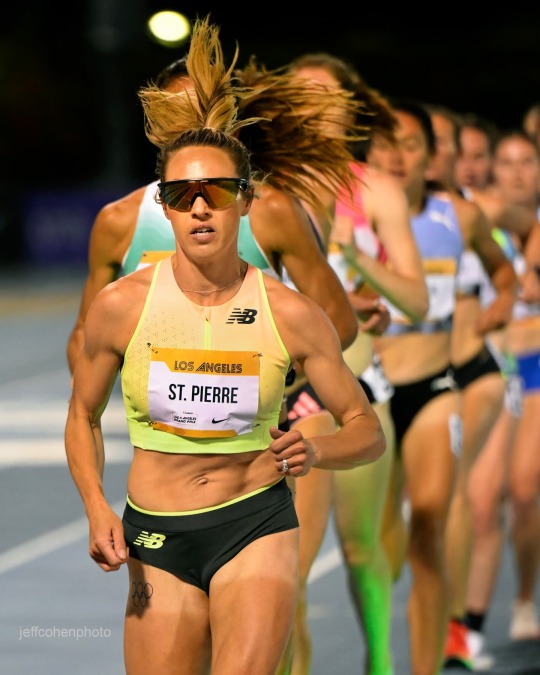
Elle St. Pierre, 🇺🇸, 14:34.12 5000m win at the 2024 Los Angeles Grand Prix. Olympic standard and PB. . . . . #ellestpierre #usatf #5000m #trackandfield #roadtoparis #jeffcohenphoto #athletics #lagp @elleruns_4_her_life
12 notes
·
View notes
Text
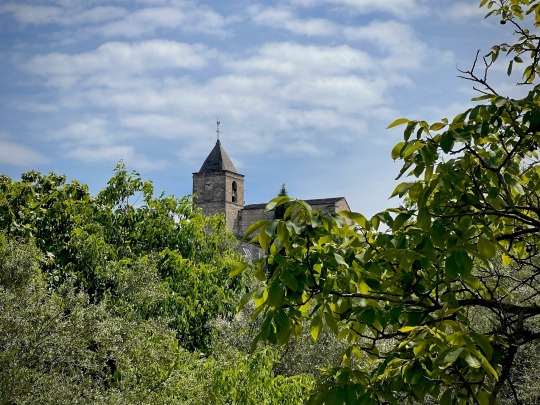
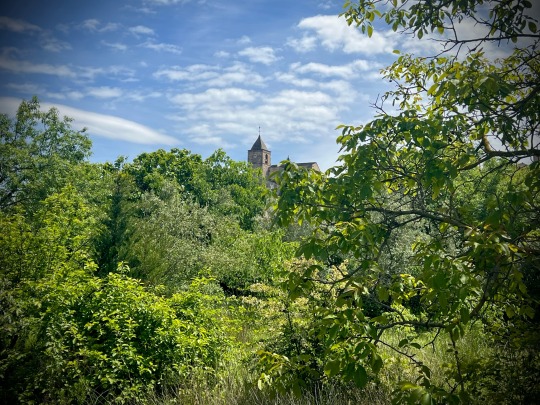
Rochefort du Gard - Le Castelas
en hauteur, sur la roche, se dresse le Castelas ancienne chapelle romane du XIIème siècle. Première église paroissiale consacrée à St Bardulphe Elle fut restaurée au XVIIe siècle et achevée, avec le clocher, en 1698.
C’est la première église paroissiale consacrée à Saint-Bardulphe. Elle existait déjà en 1195 et figurait sur la liste des possessions de l’Abbaye Saint-André de Villeneuve.
De style roman, remaniée au XVIe siècle, son chœur voûté date de la première moitié du XIIe siècle. L’ensemble de peintures murales particulièrement remarquable remonte à 1608.
En l’an 1189, l’évêque Rostaing d’Avignon donne l’église Saint Bardulphe à l’abbaye bénédictine Saint-André de Villeneuve.
Entre 1595 et 1634, de petits travaux de restauration se succèdent et le clocher est construit dans sa forme actuelle. Malgré ces travaux et les multiples demandes des habitants à l'abbaye Saint-André, l’église se dégrade.
En 1729, la chapelle Saint-Joseph est construite à l’initiative de Pierre Palijay, notable rochefortais. On y célèbre le culte jusqu’à ce que la nouvelle église Saint-Bardulphe ou église basse (église actuelle) accueille les fidèles. Cette date marque la désaffection de l’église du Castelas. Louée à des agriculteurs, elle sert de grenier à foin et quand « l’eau de la ville » arrive à Rochefort (1963-1964) la municipalité la reconvertit en château d’eau.
#original photographers#photography#photographe#photographers on tumblr#photo#france#villagedefrance#tourism#francephotography#tourisme
7 notes
·
View notes
Text
2024 olympics U.S.A. roster
Archery
Brady Ellison (Chula Vista, California)
Catalina Gnoriega (Mexicali, Mexico)
Casey Kaufhold (Lancaster, Pennsylvania)
Jennifer Mucino-Fernandez (Ciudad Mexico, Mexico)
Athletics
Capers Williamson (Greenville, South Carolina)
Kenneth Bednarek (Rice Lake, Wisconsin)
Fred Kerley (Taylor, Texas)
Noah Lyles (Alexandria, Virginia)
Erriyon Knighton (Tampa, Florida)
Christopher Bailey (Atlanta, Georgia)
Quincy Hall (Kansas City, Missouri)
Michael Norman; Jr. (Murrieta, California)
Bryce Hoppel (Midland, Texas)
Hobbs Kessler (Ann Arbor, Michigan)
Brandon Miller (St. Louis, Missouri)
Cole Hocker (Indianapolis, Indiana)
Yared Nuguse (Louisville, Kentucky)
Grant Fisher (Park City, Utah)
Abdi Nur (Phoenix, Arizona)
William Kincaid (Littleton, Colorado)
Nico Young (Newbury Park, California)
Freddie Crittenden III (Shelby Township, Michigan)
Stanley Holloway; Jr. (Chesapeake, Virginia)
Daniel Roberts (Hampton, Georgia)
C.J. Allen (Mason County, Washington)
Trevor Bassitt (Richland Township, Ohio)
Rai Benjamin (Mt. Vernon, New York)
James Corrigan (Los Angeles, California)
Kenneth Rooks (College Place, Washington)
Matthew Wilkinson (Minnetonka, Minnesota)
Quincy Wilson (Gaithersburg, Maryland)
Leonard Korir (Colorado Springs, Colorado)
Conner Mantz (Smithfield, Utah)
Clayton Young (American Fork, Utah)
Salif Mane (Bronx, New York)
Donald Scott (Apopka, Florida)
Shelby McEwen (Abbeville, Mississippi)
Sam Kendricks (Oxford, Mississippi)
Chris Nilsen (Kansas City, Missouri)
Jacob Wooten (Tomball, Texas)
Ryan Crouser (Clackamas County, Oregon)
Joe Kovacs (Bethlehem, Pennsylvania)
Payton Otterdahl (Rosemount, Minnesota)
Joseph Brown (Mansfield, Texas)
Andrew Evans (Portage, Michigan)
Curtis Thompson (Florence Township, New Jersey)
Daniel Haugh (Marietta, Georgia)
Rudy Winkler (Sand Lake, New York)
Heath Baldwin (Kalamazoo, Michigan)
Harrison Williams (Houston, Texas)
Zach Ziemek (Addison Township, Illinois)
Malcolm Clemens (Oakland, California)
Vernon Turner (Yukon, Oklahoma)
Jeremiah Davis (Lee County, Florida)
Jarrion Lawson (Texarkana, Texas)
Russell Robinson (Winter Garden, Florida)
JuVaughn Harrison (Huntsville, Alabama)
Sam Mattis (East Brunswick Township, New Jersey)
Graham Blanks (Athens, Georgia)
Christian Coleman (Fayetteville, Georgia)
Courtney Lindsey (Rock Island, Illinois)
Kyree King (Ontario, California)
Vernon Norwood (New Orleans, Louisiana)
Bryce Dedmon (MIssouri City, Texas)
Melissa Jefferson (Georgetown, South Carolina)
Sha'Carri Richardson (Dallas, Texas)
Twanisha Terry (Miami, Florida)
Brittany Brown (Upland, California)
McKenzie Long (Pickerington, Ohio)
Gabby Thomas (Northampton, Massachusetts)
Aaliyah Butler (Ft. Lauderdale, Florida)
Kendall Ellis (Pembroke Pines, Florida)
Alexis Holmes (Hamden, Connecticut)
Nia Akins (San Diego, California)
Juliette Whittaker (Laurel, Maryland)
Isabella Whittaker (Laurel, Maryland)
Allie Wilson (Nether Providence Township, Pennsylvania)
Emily Mackay (Union, New York)
Elle Purrier-St. Pierre (Montgomery, Vermont)
Elise Cranny (Boulder County, Colorado)
Karissa Schweizer (Urbandale, Iowa)
Weini Kelati-Frezghi (Leesburg, Virginia)
Alaysha Johnson (Houston, Texas)
Masai Russell (Montgomery County, Maryland)
Grace Stark (White Lake Charter Township, Michigan)
Anna Cockrell (Charlotte, North Carolina)
Jasmine Jones (Atlanta, Georgia)
Sydney McLaughlin-Levrone (Dunellen, New Jersey)
Valerie Constien (Vail, Colorado)
Marisa Howard (Boise, Idaho)
Courtney Wayment-Smith (Layton, Utah)
Dakotah Lindwurm (St. Francis, Minnesota)
Fiona O'Keeffe (Davis, California)
Emily Sisson (Chesterfield, Missouri)
Tara Davis-Woodhall (Agoura Hills, California)
Jasmine Moore (Grand Prairie, Texas)
Monae Nichols (Winter Haven, Florida)
Tori Franklin (Chicago, Illinois)
Keturah Orji (Mt. Olive Township, New Jersey)
Vashti Cunningham (Las Vegas, Nevada)
Rachel Glenn (Long Beach, California)
Brynn King (Montgomery County, Texas)
Katie Moon (Olmsted Falls, Ohio)
Bridget Williams (Hempfield Township, Pennsylvania)
Chase Jackson (Los Alamos County, New Mexico)
Jaida Ross (Medford, Oregon)
Raven Saunders (Charleston, South Carolina)
Valarie Allman (Longmont, Colorado)
Veronica Fraley (Zebulon, North Carolina)
Maggie Malone-Hardin (Lincoln, Nebraska)
Annette Echikunwoke (Pickerington, Ohio)
DeAnna Price (Troy, Missouri)
Erin Reese (Elk Grove Township, Illinois)
Taliyah Brooks (Wichita Falls, Texas)
Anna Hall (Douglas County, Colorado)
Chari Hawkins (Rexburg, Idaho)
Whittni Morgan (Panguitch, Utah)
Parker Valby (Tampa, Florida)
Rachel Tanczos (Bethlehem, Pennsylvania)
Jayden Ulrich (Wood River, Illinois)
Aleia Hobbs (New Orleans, Louisiana)
Tamari Davis (Gainesville, Florida)
Kaylyn Brown (Charlotte, North Carolina)
Quanera Hayes (Hope Mills, North Carolina)
Shamier Little (Chicago, Illinois)
Badminton
Joshua Yuan (Fremont, California)
Howard Shu (Los Angeles, California)
Vinson Chiu (Milpitas, California)
Zhang Beiwen (Las Vegas, Nevada)
Annie Xu (San José, California)
Kerry Xu (San José, California)
Jennie Gai (Fremont, California)
Basketball
Wardell Curry; Jr. (Charlotte, North Carolina)
Anthony Edwards (Atlanta, Georgia)
LeBron James (Akron, Ohio)
Kevin Durant (Rockville, Maryland)
Kawhi Leonard (Riverside, California)
Tyrese Haliburton (Oshkosh, Wisconsin)
Jayson Tatum (Creve Coeur, Missouri)
Joel Embiid (Gainesville, Florida)
Jrue Holiday (Los Angeles, California)
Edrice Adebayo (Pinetown, North Carolina)
Anthony Davis; Jr. (Chicago, Illinois)
Devin Booker (Moss Point, Mississippi)
Canyon Barry (Colorado Springs, Colorado)
Jim Fredette (Glens Falls, New York)
Kareem Maddox (Ventura County, California)
Dylan Travis (Bellevue, Nebraska)
Jewell Loyd (Niles Township, Illinois)
Kelsey Plum (La Jolla, California)
Sabrina Ionescu (Orinda, California)
Kahleah Copper (Philadelphia, Pennsylvania)
Chelsea Gray (Manteca, California)
A'Ja Wilson (Columbia, South Carolina)
Breanna Stewart (Cicero, New York)
Napheesa Collier (Jefferson City, Missouri)
Diana Taurasi (Chino, California)
Jackie Young (Princeton, Indiana)
Alyssa Thomas (Harrisburg, Pennsylvania)
Brittney Griner (Houston, Texas)
Cassidie Burdick (Matthews, North Carolina)
Dearica Hamby (Norcross, Georgia)
Rhyne Howard (Cleveland, Tennessee)
Hailey Van Lith (Wenatchee, Washington)
Boxing
Roscoe Hill (Houston, Texas)
Jahmal Harvey (Prince George's County, Maryland)
Omari Jones (Orlando, Florida)
Joshua Edwards (Houston, Texas)
Jennifer Lozano (Laredo, Texas)
Alyssa Mendoza (Caldwell, Idaho)
Jajaira Gonzalez (Glendora, California)
Morelle McCane (Cleveland, Ohio)
Breakdancing
Jeff Louis (Houston, Texas)
Victor Montalvo (Kissimmee, Florida)
Logan Edra (Chula Vista, California)
Sunny Choi (Queens, New York)
Canoeing
Casey Eichfeld (Charlotte, North Carolina)
Aaron Small (Seattle, Washington)
Jonas Ecker (Bellingham, Washington)
Evy Leibfarth (Sylva, North Carolina)
Nevin Harrison (Seattle, Washington)
Cycling
Marcus Christopher (Canton, Ohio)
Cameron Wood (Great Falls, Montana)
Matteo Jorgenson (Boise, Idaho)
Brandon McNulty (Phoenix, Arizona)
Magnus Sheffield (Pittsford, New York)
Grant Koontz (Houston, Texas)
Riley Amos (Durango, Colorado)
Christopher Blevins (Durango, Colorado)
Justin Dowell (Virginia Beach, Virginia)
Kamren Larsen (Bakersfield, California)
Daleny Vaughn (Tucson, Arizona)
Chloé Dygert (Brownsburg, Indiana)
Olivia Cummins (Ft. Collins, Colorado)
Kristen Faulkner (Homer, Alaska)
Jennifer Valente (San Diego, California)
Lily Williams (Tallahassee, Florida)
Haley Batten (Park City, Utah)
Savilia Blunk (Marin County, California)
Perris Benegas (Raleigh, North Carolina)
Hannah Roberts (Buchanan, Michigan)
Felicia Stancil (Lake Villa Township, Illinois)
Alise Willoughby (St. Cloud, Minnesota)
Diving
Andrew Capobianco (Holly Springs, North Carolina)
Carson Tyler (Moultrie, Georgia)
Tyler Downs (Ballwin, Missouri)
Greg Duncan (Fairfax County, Virginia)
Daryn Wright (Plainfield, Indiana)
Sarah Bacon (Indianapolis, Indiana)
Alison Gibson (Houston, Texas)
Delaney Schnell (Tucson, Arizona)
Kassidy Cook (Montgomery County, Texas)
Jessica Parratto (Dover, New Hampshire)
Equestrian
Marcus Orlob (Palm Beach County, Florida)
Steffen Peters (San Diego, California)
William Coleman III (Madison County, Virginia)
Boyd Martin (West Fallowfield Township, Pennsylvania)
Kent Farrington (Chicago, Illinois)
McLain Ward (Southeast, New York)
Caroline Pamukcu (Springhill, Pennsylvania)
Adrienne Lyle (Coupeville, Washington)
Laura Kraut (Camden, South Carolina)
Fencing
Colin Heathcock (Beijing, China)
Filip Dolegiewicz (Park Ridge, Illinois)
Nick Itkin (Los Angeles, California)
Alexander Massialas (San Francisco, California)
Gerek Meinhardt (San Francisco, California)
Miles Chamley-Watson (New York, New York)
Eli Dershwitz (Sherborn, Massachusetts)
Mitchell Saron (Ridgewood, New Jersey)
Anne Cebula (New York, New York)
Hadley Husisian (Fairfax County, Virginia)
Margherita Guzzi-Vincenti (Delafield Township, Wisconsin)
Lauren Scruggs (Queens, New York)
Tatiana Nazlymov (Montgomery County, Maryland)
Magda Skarbonkiewicz (Portland, Oregon)
Elizabeth Tartakovsky (Livingston Township, New Jersey)
Maia Chamberlain (Menlo Park, California)
Kat Holmes (Washington, D.C.)
Jacqueline Dubrovich (Maplewood Township, New Jersey)
Lee Kiefer (Lexington, Kentucky)
Maia Weintraub (Philadelphia, Pennsylvania)
Field Hockey
Kelee Lepage (Honey Brook, Pennsylvania)
Abigail Tamer (Dexter, Michigan)
Ashley Sessa (Royersford, Pennsylvania)
Megan Valzonis (San Diego, California)
Brooke DeBerdine (Millersville, Pennsylvania)
Emma DeBerdine (Millersville, Pennsylvania)
Madeleine Zimmer (Derry Township, Pennsylvania)
Amanda Golini (Randolph Township, New Jersey)
Ashley Hoffman (Mohnton, Pennsylvania)
Elizabeth Yeager (Greenwich, Connecticut)
Leah Crouse (Virginia Beach, Virginia)
Alexandra Hammel (Duxbury, Massachusetts)
Sophia Gladieux (Olney Township, Pennsylvania)
Karlie Kisha (Hamburg, Pennsylvania)
Kelsey Bing (Houston, Texas)
Meredith Sholder (Alburtis, Pennsylvania)
Soccer
Patrick Schulte (St. Charles, Missouri)
Gabriel Slonina (Addison Township, Illinois)
Nathan Harriel (Oldsmar, Florida)
John Tolkin (Chatham, New Jersey)
Maximilian Dietz (New York, New York)
Caleb Wiley (Atlanta, Georgia)
Walker Zimmerman (Lawrenceville, Georgia)
Miles Robinson (Arlington, Massachusetts)
Francis Tessmann (Birmingham, Alabama)
Djordje Mihailović (Chicago, Illinois)
Jack McGlynn (Queens, New York)
Gianluca Busio (Kansas City, Missouri)
Benjamín Cremaschi (Miami, Florida)
Paxten Aaronson (Medford Township, New Jersey)
Duncan McGuire (Omaha, Nebraska)
Taylor Booth (Weber County, Utah)
Griffin Yow (Clifton, Virginia)
Kevin Paredes (Loudoun County, Virginia)
Alyssa Naeher (Bridgeport, Connecticut)
Emily Fox (Loudoun County, Virginia)
Korbin Albert (Avon Township, Illinois)
Naomi Girma-Aweke (San José, California)
Trinity Rodman-Moyer (Newport Beach, California)
Casey Krueger (Naperville, Illinois)
Crystal Soubrier (Hempstead, New York)
Catarina Macário (San Diego, California)
Mallory Swanson (Chicago, Illinois)
Lindsey Horan (Golden, Colorado)
Sophia Smith (Windsor, Colorado)
Tierna Davidson (Menlo Park, California)
Jenna Nighswonger (Newport Beach, California)
Emily Sonnett (Marietta, Georgia)
Jaedyn Shaw (Frisco, Texas)
Rose Lavelle (Cincinnati, Ohio)
Samantha Coffey (Mt. Pleasant, New York)
Casey Murphy (Bridgewater Township, New Jersey)
Carolyn Campbell (Kennesaw, Georgia)
Croix Bethune (Alpharetta, Georgia)
Katherine Hershfelt (Marietta, Georgia)
Lynn Williams (Fresno, California)
Golf
Wyndham Clark (Scottsdale, Arizona)
Collin Morikawa (Las Vegas, Nevada)
Xander Schauffele (Las Vegas, Nevada)
Scottie Scheffler (Dallas, Texas)
Nelly Korda (Bradenton, Florida)
Lilia Vu (Fountain Valley, California)
Rose Zhang (Irvine, California)
Gymnastics
Asher Hong (Tomball, Texas)
Paul Juda (Vernon Township, Illinois)
John Malone (Sarasota, Florida)
Stephen Nedoroscik (Sarasota, Florida)
Fred Richard (Stoughton, Massachusetts)
Aliaksei Shostak (Lafayette, Indiana)
Simone Biles-Owens (Houston, Texas)
Jade Carey (Corvallis, Oregon)
Jordan Chiles (Los Angeles, California)
Suni Lee (Auburn, Alabama)
Hezly Rivera (Plano, Texas)
Evita Griškėnas (Orland Township, Illinois)
Jessica Stevens (Howard County, Maryland)
Judo
Jack Yonezuka (West Long Branch, New Jersey)
John Jayne (Chicago, Illinois)
Marie Laborde (Kenosha, Wisconsin)
Angelica Delgado (Miami, Florida)
Pentathlon
Jess Davis (Bethlehem, Connecticut)
Rowing
William Bender (Norwich, Vermont)
Oliver Bub (Westport, Connecticut)
Ben Davison (Inverness, Florida)
Sorin Koszyk (Grosse Pointe Park, Michigan)
Chris Carlson (Bedford, New Hampshire)
Peter Chatain (New Trier Township, Illinois)
Henry Hollingsworth (Dover, Massachusetts)
Rielly Milne (Woodinville, Washington)
Evan Olson (Bothell, Washington)
Pieter Quinton (Portland, Oregon)
Nicholas Rusher (West Bend, Wisconsin)
Christian Tabash (Alexandria, Virginia)
James Plihal (St. Louis, Missouri)
Justin Best (Kennett Square, Pennsylvania)
Liam Corrigan (Old Lyme, Connecticut)
Michael Grady (Pittsburgh, Pennsylvania)
Nick Mead (Tredyffrin Township, Pennsylvania)
Clark Dean (Sarasota, Florida)
Azja Czajkowski (Chula Vista, California)
Sophia Vitas (Franklin, Wisconsin)
Kristi Wagner (Weston, Massachusetts)
Emily Kallfelz (Jamestown, Rhode Island)
Kaitlin Knifton (Austin, Texas)
Mary Mazzio-Manson (Wellsley, Massachusetts)
Kelsey Reelick (Brookfield, Connecticut)
Teal Cohen (Dallas, Texas)
Emily Delleman (Davenport, Iowa)
Grace Joyce (Northfield Township, Illinois)
Lauren O'Connor (Westfield, Massachusetts)
Cristina Castagna (Cincinnati, Ohio)
Claire Collins (Fairfax County, Virginia)
Margaret Hedeman (Concord, Massachusetts)
Kara Kohler (Clayton, California)
Jessica Thoennes (Madison, Wisconsin)
Mary Reckford (Millburn Township, New Jersey)
Michelle Sechser (San Luis Obispo, California)
Molly Bruggeman (Dayton, Ohio)
Charlotte Buck (Orangetown, New York)
Olivia Coffey (Elmira, New York)
Meghan Musnicki (Naples, New York)
Regina Salmons (Methuen, Massachusetts)
Madeleine Wanamaker (Neenah, Wisconsin)
Rugby
Aaron Cummings (Grand Haven, Michigan)
Orrin Bizer (Montgomery County, Texas)
Naima Fuala'au (Hayward, California)
Malacchi Esdale (Newark, Delaware)
Kisi Unufe (Provo, Utah)
Matai Leuta (Seaside, California)
Marcus Tupuola (Carson, California)
Kevon Williams (Houston, Texas)
Stephen Tomasin (Santa Rosa, California)
Madison Hughes (Lancaster, Massachusetts)
Perry Baker (Port Orange, Florida)
Lucas Lacamp (San Diego, California)
Ariana Ramsey (Philadelphia, Pennsylvania)
Sarah Levy (San Diego, California)
Alexandria Sedrick (Herriman, Utah)
Alena Olsen (Grand Rapids, Michigan)
Leyla Kelter (Anchorage, Alaska)
Ilona Maher (Burlington, Vermont)
Kayla Canett (Fallbrook, California)
Kristi Kirsche (Franklin, Massachusetts)
Lauren Doyle (Macon, Illinois)
Naya Tapper (Charlotte, North Carolina)
Samantha Sullivan (Fayetteville, North Carolina)
Stephanie Rovetti (Reno, Nevada)
Sailing
Noah Lyons (Clearwater, Florida)
Markus Edegran (West Palm Beach, Florida)
Ian Barrows (St. Thomas, U.S. Virgin Islands)
David Liebenberg (Richmond, California)
Hans Henken (Laguna Beach, California)
Stuart McNay (Marion, Massachusetts)
Dominique Stater (Montgomery County, Maryland)
Erika Reineke (Ft. Lauderdale, Florida)
Sarah Newberry-Moore (Miami, Florida)
Daniela Moroz (Berkeley, California)
Stephanie Roble (East Troy, Wisconsin)
Maggie Shea (New Trier Township, Illinois)
Lara Dallman-Weiss (Miami, Florida)
Shooting
Sgt. Ivan Roe (Manhattan, Montana)
Will Hinton (Dacula, Georgia)
Conner Prince (Burleson, Texas)
Henry Leverett (Bainbridge, Georgia)
Sfc. Keith Sanderson (Plymouth, Massachusetts)
Derrick Mein (Paola, Kansas)
Vincent Hancock (Ft. Worth, Texas)
Katelyn Abeln (Douglasville, Georgia)
Ada Korkhin (Brookline, Massachusetts)
Ryann Phillips (Borden County, Texas)
Sgt. Sagen Maddelena (Woodland, California)
Mary Tucker (Pineville, North Carolina)
Alexis Lagan (Boulder City, Nevada)
Rachel Tozier (Pattonsburg, Missouri)
Austen Smith (Dallas, Texas)
Dania Vizzi (Pasco County, Florida)
Skateboarding
Gavin Bottger (Vista, California)
Tate Carew (San Diego, California)
Chris Joslin (Cerritos, California)
Tom Schaar (Malibu, California)
Jagger Eaton (Mesa, Arizona)
Nyjah Huston (Davis, California)
Ruby Lilley (Oceanside, California)
Minna Stess (Petaluma, California)
Paige Heyn (Tempe, Arizona)
Poe Pinson (Fernandina Beach, Florida)
Bryce Wettstein (Encinitas, California)
Mariah Duran (Albuquerque, New Mexico)
Swimming
Caeleb Dressel (Orange Park, Florida)
Chris Guiliano (Amity Township, Pennsylvania)
Jack Alexy (Mendham Borough, New Jersey)
Luke Hobson (Reno, Nevada)
Aaron Shackell (Carmel, Indiana)
Kieran Smith (Ridgefield, Connecticut)
Robert Finke (Clearwater, Florida)
Luke Whitlock (Noblesville, Indiana)
David Johnston (Lake Forest, California)
Joseph Armstrong (Dover, Ohio)
Ryan Murphy (Jacksonville, Florida)
Keaton Jones (Gilbert, Arizona)
Nic Fink (Morristown, New Jersey)
Charlie Swanson (Richmond, Virginia)
Matthew Fallon (Warren Township, New Jersey)
Josh Matheny (Pittsburgh, Pennsylvania)
Thomas Heilman (Albemarle County, Virginia)
Luca Urlando (Sacramento, California)
Shaine Casas (McAllen, Texas)
Carson Foster (Cincinnati, Ohio)
Chase Kalisz (Harford County, Maryland)
Ryan Held (Springfield, Illinois)
Matt King (Snohomish, Washington)
Brooks Curry (Dunwoody, Georgia)
Drew Kibler (Carmel, Indiana)
B.J. Pieroni (Chesterton, Indiana)
Ivan Puskovitch (West Chester, Pennsylvania)
Jaime Czarkowski (Calgary, Alberta)
Keana Hunter (Issaquah, Washington)
Audrey Kwon (Seattle, Washington)
Jacklyn Luu (Milpitas, California)
Daniella Ramirez (Miami, Florida)
Ruby Remati (Andover, Massachusetts)
Megumi Field (Cerritos, California)
Anita Alvarez (Buffalo, New York)
Simone Manuel (Sugar Land, Texas)
Gretchen Walsh (Nashville, Tennessee)
Alexandra Walsh (Greenwich, Connecticut)
Kate Douglass (Pelham, New York)
Torri Huske (Arlington County, Virginia)
Erin Gemmell (Montgomery County, Maryland)
Claire Weinstein (White Plains, New York)
Katie Ledecky (Montgomery County, Maryland)
Paige Madden (Mobile, Alabama)
Katie Grimes (Las Vegas, Nevada)
Katherine Berkoff (Missoula, Montana)
Regan Smith (Lakeville, Minnesota)
Phoebe Bacon (Chevy Chase, Maryland)
Lilly King (Evansville, Indiana)
Emma Weber (Denver, Colorado)
Alexandra Shackell (Carmel, Indiana)
Emma Weyant (Sarasota, Florida)
Erika Connolly (Cornelius, North Carolina)
Abbey Weitzeil (Santa Clarita, California)
Anna Peplowski (Metamora Township, Illinois)
Mariah Denigan (Fairfield, Ohio)
Rock climbing
Zach Hammer (Salt Lake City, Utah)
Colin Duffy (Broomfield, Colorado)
Jesse Grupper (New York, New York)
Sam Watson (Southlake, Texas)
Natalia Grossman (Boulder, Colorado)
Brooke Raboutou (Boulder, Colorado)
Emma Hunt (Woodstock, Georgia)
Piper Kelly (Indianapolis, Indiana)
Surfing
Griffin Colapinto (San Clemente, California)
John Florence (Honolulu County, Hawaii)
Caroline Marks (Melbourne Beach, Florida)
Carissa Moore (Honolulu, Hawaii)
Caitlin Simmers (Oceanside, California)
Table tennis
Kanak Jha (Milpitas, California)
Rachel Sung (San José, California)
Amy Wang (Mantua Township, New Jersey)
Lily Zhang (Redwood City, California)
Taekwondo
Carl Nickolas; Jr. (Brentwood, California)
Jonathan Healy (Houston, Texas)
Faith Dillon (Las Vegas, Nevada)
Kristina Teachout (Palm Bay, Florida)
Tennis
Christopher Eubanks (Atlanta, Georgia)
Taylor Fritz (Rancho Palos Verdes, California)
Marcos Girón (Thousand Oaks, California)
Tommy Paul (Boca Raton, Florida)
Austin Krajicek (Plano, Texas)
Rajeev Ram (Carmel, Indiana)
Danielle Collins (St. Petersburg, Florida)
Cori Gauff (Delray Beach, Florida)
Emma Navarro (Charleston, South Carolina)
Jessica Pegula (Boca Raton, Florida)
Desirae Krawczyk (Palm Desert, California)
Trialthlon
Morgan Pearson (Boulder, Colorado)
Seth Rider (Germantown, Tennessee)
Kirsten Kasper (Boulder, Colorado)
Taylor Knibb (Boulder, Colorado)
Taylor Spivey (Redondo Beach, California)
Volleyball
Andy Benesh (Rancho Palos Verdes, California)
Miles Partain (Los Angeles, California)
Miles Evans (Santa Barbara, California)
Chase Budinger (Carlsbad, California)
Matt Anderson (West Seneca, New York)
Aaron Russell (Howard County, Maryland)
Jeff Jendryk II (Evanston, Illinois)
T.J. DeFalco (Huntington Beach, California)
Micah Christenson (Honolulu, Hawaii)
Maxwell Holt (Cincinnati, Ohio)
Micah Ma'a (Honolulu County, Hawaii)
Thomas Jaeschke (Wheaton, Illinois)
Garrett Muagututia (Oceanside, California)
Taylor Averill (Portland, Oregon)
David Smith (Santa Clarita, California)
Erik Shoji (Honolulu, Hawaii)
Taryn Kloth (Sioux Falls, South Dakota)
Kelly Cheng (Fullerton, California)
Sarah Hughes (Costa Mesa, California)
Jordyn Poulter (Aurora, Colorado)
Avery Skinner (Katy, Texas)
Justine Wong-Orantes (Cypress, California)
Lauren Carlini (Aurora, Illinois)
Jordan Larson (Hooper, Nebraska)
Annie Drews (Elkhart, Indiana)
Jordan Thompson (Edina, Minnesota)
Haleigh Washington (Clear Creek County, Colorado)
Dana Rettke (Riverside Township, Illinois)
Kathryn Plummer (Aliso Viejo, California)
Kelsey Cook (Hanover Township, Illinois)
Chiaka Ogbogu (Coppell, Texas)
Water polo
Adrian Weinberg (Los Angeles, California)
Chase Dodd (Huntington Beach, California)
Ryder Dodd (Huntington Beach, California)
Johnny Hooper (Los Angeles, California)
Marko Vavic (Rancho Palos Verdes, California)
Alex Obert (Loomis, California)
Hannes Daube (Long Beach, California)
Luca Cupido (Newport Beach, California)
Ben Hallock (Los Angeles, California)
Dylan Woodhead (San Anselmo, California)
Alex Bowen (San Diego, California)
Max Irving (Long Beach, California)
Drew Holland (Orinda, California)
Tara Prentice (Murrieta, California)
Jenna Flynn (San José, California)
Jewel Roemer (Lafayette, California)
Emily Ausmus (Riverside, California)
Jovana Sekulic (Newtown Township, Pennsylvania)
Ashleigh Johnson (Miami, Florida)
Maddie Musselman (Newport Beach, California)
Rachel Fattal (Los Alamitos, California)
Maggie Steffens (Danville, California)
Jordan Raney (Santa Monica, California)
Ryann Neushul (Santa Barbara County, California)
Kaleigh Gilchrist (Newport Beach, California)
Amanda Longan (Moorpark, California)
Weightlifting
Hampton Morris (Marrieta, Georgia)
Wes Kitts (Knoxville, Tennessee)
Jourdan Delacruz (Wylie, Texas)
Olivia Reeves (Chattanooga, Tennessee)
Mary Theisen-Lappen (Eau Claire, Wisconsin)
Wrestling
Payton Jacobson (Elkhorn, Wisconsin)
Spencer Lee (Murrysville, Pennsylvania)
Zain Retherford (Benton, Pennsylvania)
Kyle Dake (Lansing, New York)
Aaron Brooks (Hagerstown, Maryland)
Kyle Snyder (Montgomery County, Maryland)
Mason Parris (Lawrenceburg, Indiana)
Kamal Bey (Oak Park Township, Illinois)
Joe Rau (Chicago, Illinois)
Adam Coon (Handy Township, Michigan)
Sarah Hildebrandt (Clay Township, Indiana)
Dominique Parrish (Scotts Valley, California)
Helen Maroulis (Marquette, Michigan)
Kayla Miracle (Iowa City, Iowa)
Amit Elor (Walnut Creek, California)
Kennedy Blades (Chicago, Illinois)
#Sports#National Teams#U.S.A.#U.S.#Celebrities#Mexico#Pennsylvania#Races#South Carolina#Wisconsin#Texas#Virginia#Florida#Georgia#Missouri#Michigan#Indiana#Kentucky#Utah#Arizona#Colorado#Ohio#Washington#New York#Minnesota#Mississippi#Oregon#New Jersey#Oklahoma#Alabama
6 notes
·
View notes
Text
--Lonely mermaid--
INTRODUCTION :
Et si, du jour au lendemain, votre quotidien se retrouvait chamboulé par un changement radical d'environnement ? Imaginez être une sirène, et devoir brutalement quitter le monde de l'océan, pour vous adapter à la vie terrestre, sans rien connaître de ce monde. Et bien... C'est ce qui arrive à deux sirènes/tritons ayant élu domicile de force dans l'archipel de Sulani. Ils/Elles sont seul(e)s, isolé(e)s, sans ressources et sans aucun savoir. Votre but ? Les aider à survivre, à apprendre tout ce qui est à savoir sur la vie humaine.
DEPART :
- Le challenge se déroulera dans le monde de Sulani. - Vous devrez vous installer sur l’un des terrains présents dans le “quartier” **Lani St Taz.** - Vous commencez l'aventure avec 2 sirènes/tritons, ils peuvent être adolescent, jeune adulte et adulte. Le choix de leur sexe est libre. Cependant, si vous choisissez de jouer avec des adolescents, faites en sortes qu'ils n'aillent jamais à l'école. - Votre carte et votre terrain doivent être ENTIEREMENT vides, l'archipel de Sulani étant un lieu abandonné. - Vous débutez avec zéro simflouz, et zéro compétences. - Votre terrain devra avoir le défi de terrain hors réseau et vie simple. - Votre terrain aura les traits suivants : Esprits des îles, fantastique sol. Vous pouvez choisir le dernier. PENDANT :
- Vos sims ne pourront pas travailler. - Pour un côté réaliste à l'environnement du challenge, privilégiez l'achat de meubles en bois, en pierre, et un éclairage à la bougie dans un premier temps. - Vous pourrez utiliser l’électricité après avoir atteint le LVL 5 de la compétence bricolage (avec le sim de votre choix), et vous pourrez utiliser des papiers peint autre que du bois/de la pierre après avoir atteint le LVL 5 de peinture (avec le SIM N°2) - Vous pourrez adopter un animal au cours de la partie. - Vous pouvez faire des enfants durant votre partie, mais vous ne pourrez pas en adopter (pour plus de réalisme). - Codes de triche interdits, sauf les suivants : bb.moveobjects / bb.showhiddenobjects / bb.showliveeditobjects / testingcheats true / **cas.fulleditmode**
OBJECTIFS :
AVEC LE SIM N° 1 :
- Atteindre le LVL 10 des compétences Jardinage, composition florale et fabrication d'objet - Terminer l'aspiration Botaniste indépendante
AVEC LE SIM N°2 :
- Atteindre les LVL 10 des compétences pêche (possibilité de pêcher au fusil harpon), peinture et cuisine - Terminer l'aspiration Pro de la pêche
AVEC LE SIM DE VOTRE CHOIX :
- Compléter la compétence bricolage
QUÊTES SECONDAIRES (facultatif)
- Terminer les aspirations fermier (mod), pro des compositions florales (mod) et apiculteur (mod) avec le/les sim(s) de votre choix. - Compléter le collections Coquillages et trésors enfouis, avec le/les sim(s) de votre choix.
Aspiration fermier : https://www.mediafire.com/file/i1563fsfm71j798/justJones_HomesteaderAspiration.package/file Aspiration pro des compo florales : https://www.mediafire.com/file/reh2k0rrcmlzsi2/KIARA+ASPI.rar/file Aspiration apiculteur : https://www.mediafire.com/file/6xtvt5rmjc7thni/marlynsims_Beekeeper_Aspiration.package/file
Le challenge est réussi si toutes les conditions sont respectées, et tous les objectifs complétés.
5 notes
·
View notes
Text
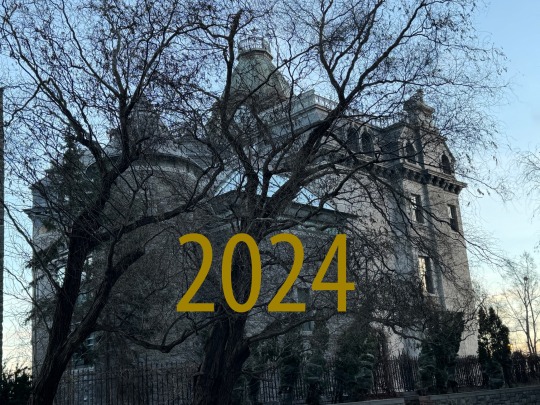


PRÉDICTION POUR L'ANNÉE 2024-
Il est traditionnel de commencer une nouvelle année avec des prédictions...
Je m'avance à en faire trois pour 2024!
1. Donald J. Trump sera réélu Président des États-Unis le mardi 5 novembre 2024;
2. L'Intelligence artificielle s'installera au centre de notre vie quotidienne pour devenir totalement incontournable;
3. Le travail à domicile continuera de dominer la vie économique et les espaces à bureaux devront changer de vocation.
Il est évident que l'élection de Donald Trump, si elle se réalise, ne sera pas active avant janvier de 2025, mais l'échiquier politique prendra toute sa forme en 2024, et ce pour influencer la politique mondiale jusqu'en 2030, soit jusqu'à la fin de la présente décennie.
Selon-moi, le monde sera polarisé plus que jamais en 2024 et après. Le pouvoir sur la planète sera divisé en quatre grandes parties, chacune incontournable.
On peut présumer que Vladimir Poutine sera le Président de la Russie jusqu'en 2030 et pour cette raison, la Russie et la Chine avec leurs alliés d'un bord deviendront les plus influentes; les États-Unis repliés sur eux-même formeront le deuxième pôle, tandis que l'Europe formera un troisième pôle mondial. Il restera ensuite un quatrième pôle politique, isolé des trois autres, mais significatif en puissance militaire, soit celui des pays comme l'Iran, la Corée du Nord et ses alliés.
Israel devra s'accrocher à l'un des pouvoirs de la planète, car aucune survie ne sera possible en dehors des quatre pôles mondiaux.
Pour la prochaine année, en ce qui concerne le Canada, la popularité grandissante de Pierre Poilièvre ramène la possibilité à venir d’un style de gouvernance à la Stephen Harper, après l’élection d’octobre 2025, si Justin Trudeau attend à la date limite d’une élection canadienne. Rappelons qu'il est minoritaire et que sa survie dépend entièrement de l'appui du NPD.
Au Québec, François Legault n’a pas à déclencher d’élection générale avant octobre 2026, soit pas avant trois ans. Il faudra voir si les autres partis deviennent d’ici là des alternatives viables, ce qui n’est pas le cas présentement malgré la très forte baisse de popularité de Legault et la grande popularité de Paul St-Pierre Plamondon. La popularité de Plamondon est cependant trop en avance de l'élection, car les Québécois votent généralement selon le climat politique qui précède l'année avant le vote. Plamondon me fait penser à Mario Dumont en 2007 alors que les sondages le projetaient premier ministre, mais qui avait échoué, de justesse, malgré ses 41 sièges face à Jean Charest qui avait remporté 48 sièges de député. L'handicap de Plamondon, qui a une personnalité très attachante, sera la séparation du Québec, un but politique qui n' a jamais été accepté par la majorité des Québécois.
C'est évidemment à suivre, et je me trompe, parfois...
Pour le moment en ce 1er janvier, je vous souhaite à toutes et tous une bonne année 2024! Beaucoup d’amour, et surtout le bonheur de vivre!
2 notes
·
View notes
Text
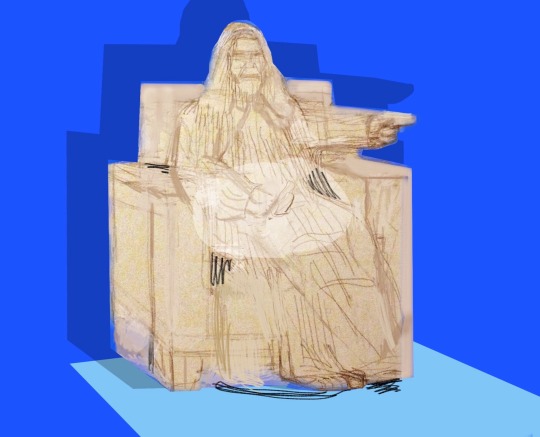
Ça c’est le vrai Dieu les filles. Vous extrapolez monsieur le juge, ce n’est pas marqué nulle part que c’est le bras droit qu’il lève. Il se crosse avec sa main droite et il montre, ou il regarde le diable de la main gauche. Même pas une fille. Mais son nom c’est le Très-Haut, donc il n’aime pas ce qui est bas, mais il aime les scarfs. Votre Dieu n’a pas de forme, il n’est pas capable de montrer une direction ou d’indiquer quelque chose.
Carlos (suite)
En 1984 ou 85, quand je suis revenu de Vancouver, alors que je restais dans le minuscule boudoir de Mme Audit à Charlesbourg, le Seigneur me demanda: Steve, que vois-tu? Je lui dis: Je vois le Cap Diamant et la haute ville de Québec. Je vois la Côte du Palais et la rue Saint-Jean, et le roc sur laquelle elle est assise est transparent, à l'intérieur de la pierre, je vois de grands brasiers. Ce sont des cages, comme celles que l'on met l'hiver pour protéger les arbres dans les rues de la ville, avec des barreaux, et à l'intérieur, au lieu des arbres, il y a des gens prisonniers des barreaux, et ils sont en feux. C’est du gaz propane avec de l’air comprimé. Ils sont tous accouplés de chaque côté de la rue, et dispersés à égale distance le long des artères commerciales de la vieille ville, sur la rue St-Jean et la Côte du Palais, à l'intérieur des remparts, mais ils sont enfoncés à au moins vingt mètres de profondeur dans le roc, sous la surface, il y a une autre ville avec des trottoirs en dégradés, et l’incendie commence sur la rue Ste-Catherine à Montréal, dans l’appartement d’Yvon Gosselin et Odette Tremblay, dans le Village, et au milieu d'eux, il y a un jeune homme qui court de toutes ses forces pour échapper au brasier et sortir du roc. Il court en descendant le trottoir sans fin de l'escalier, toujours dans le roc, et l'origine du trottoir se trouve à Montréal. Il a un manteau, une froc de cuir, des jeans, et des bottes noires comme je n'en ai pas. Moi je suis habillé en guenilles sur le BS. Alors le Seigneur lui dit dans un murmure:
— Voici pour mon serviteur (celui qui est bien habillé, il a défoncé la porte d’Yvon Gosselin et Odette Tremblay à Montréal, et il se sauve dans l’escalier sans leur toucher pour ne pas se brûler, il court avant de passer au feu et il aboutit à Québec en passant à travers du roc Ok la police). Ensuite il dit : Voilà pour les marchands du bas des murailles (ils brûlent).
Et vous me connaissez, c’est l’Ange Gabriel qui m’a dit que marchand du bas des murailles c’était long, ça dépasse. Il m’a dit aussi que moi mon nom c’est mon serviteur.
Il l’a appelé ce grand homme devant moi, et il dit qu’il a échoué dans tout ce qu’il a fait. Et toi, Israël, mon serviteur, Jacob, que j’ai choisi, race d’Abraham, mon ami, toi que j’ai saisi aux extrémités de la terre, que j’ai appelé des contrées lointaines, je t’ai dit : « Tu es mon serviteur, je t’ai choisi, je ne t’ai pas rejeté. » Ne crains pas car je suis avec toi, ne te laisse pas émouvoir car je suis ton Dieu; je t’ai fortifié et je t’ai aidé, je t’ai soutenu de ma droite justicière. Voici qu’ils seront honteux et humiliés, tous ceux qui s’enflammaient contre toi. Ils seront réduits à rien et périront, ceux qui n’étaient jamais contents. Tu les chercheras et tu ne les trouveras pas, ceux qui chialaient tout le temps; ils seront réduits à rien, anéantis, ceux qui montaient tout le temps. Car moi, Dieu Très-Haut, ton Dieu, je te saisis la main droite, je te dis : « Ne crains pas, c’est moi qui te viens en aide. »
Rien ne changera ce qui s’est passé. Et je reconnu sa voix, c’était la voix de celui qui m’était apparu à New York en janvier 1982 et qui m’avait dit celui-là est Satan. C’était un clochard, un quêteux. Donc Dieu était présent avec nous sur cette terre durant tout ce temps-là où j’étais dans l’Ouest. Il a montré qu’il était plus intelligent que les autres. Même si ça ne se peut pas que le Christ soit monté au ciel comme Brizilia avec son corps quand il est ressuscité, ça n’empêche pas Paul d’avoir vu Dieu sur le chemin de Damas. Cherchez une explication. C’était prévu qu’on l’oublierait, quand il reviendrait.
1 note
·
View note
Text
TOUT À FAIT D'ACCORD, LE LEADERSHIP EST TOTALEMENT CHARNEL ET DÉMONIAQUE!
Un conducteur ou surveillant (évêque), est quelqu'un qui conduit, non qui dirige ou domine, comme un leader d'entreprise le ferait, et comme les pasteurs de grandes églises, des synagogues de satan, le font!!!
CE RÔLE N'EXISTE PAS DANS LES ÉCRITURES ET VIENT DU DIABLE!
D'ailleurs, nul part dans la Parole, nous voyons un pasteur unique, autocratique, d'un système cléricale pyramidale comme dans le monde, au dessus des autres brebis, supposées former le corps de Christ;
un corps handicapé ou la tête a été usurpée par un leader, un petit roi, qui seul est oint de Dieu et à qui appartient tous les dons et l'autorité, privant les autres de l'onction qu'ils ont reçu de l'Esprit, dont il les supplante... les supplante de la vie de l'Esprit, de la vie Christ!
Les écritures parlent d'un collège d'anciens, au milieu des brebis du seigneurs, brebis du berger elles-mêmes, choisies non à cause de leur diplômes théologiques (et autres) obtenus de façon séculière, mais bien à cause de leur maturité dans l'Amour et la compassion, appointées et oints par Dieu et non par des hommes religieux;
des anciens ou conducteurs qui surveillent le bon déroulement de l'assemblée, et s’assurent que chacun participe à la table du maître;
le seigneur, qui par son Esprit est le seul vrai berger, qui règne sur sa maison...
ces anciens étant l'autorité déléguée, soumis les uns aux autres dans l'amour et la crainte de Dieu, à qui ils rendront des comptes, et ainsi au st Esprit, dans l'amour et la compassion pour les brebis du seigneur, que celui-ci leur a confié, comme un berger le ferait avec ses chiens de bergers, des chiens de garde, qui lui obéissent au doigt et à l’œil, étant sensibles au son Esprit, ce , sacrifiant leur vie, comme Christ l'a fait, pour le biens du troupeau en entier!
afin que, tous ensembles, comme des frères, les anciens et les autres brebis, atteignent la stature parfaite de Jésus-Christ...
de plus, il n'y a pas de poste d’ancien qui soit permanent et non révocable; si un ancien déroge de la saine doctrine, ou tombe dans un péché, il sera dénoncer selon le processus biblique, par les saints, et sa charge lui sera retirée par les autres anciens...
Un pupitre sur une estrade, ou un homme domine par ses prédications et autres, que tous écoutent à la place du st Esprit et de Christ, avec à sa suite sa petite cour cléricale, au dessus des autres membres de l'assemblée des saints, assis eux en rang de poireau dans une battisse de pierre, que l'on appelle à tord, église (une synagogue et non un corp vivant);
est un système démoniaque a été hérité de l'église catholique et vient de la réforme, et non de Dieu!
0 notes
Text
Vie nouvelle ! 22/01/2025
Les choses anciennes sont passées ; voici toutes choses sont devenues nouvelles. Et tout cela vient de Dieu, qui nous a réconciliés avec lui par Christ. 2 Corinthiens 5.7, 18
Les choses anciennes reviennent souvent dans notre mémoire. Le souvenir de nos fautes peut nous empêcher d’aller de l’avant. La Parole de Dieu nous rapporte plusieurs exemples d’hommes et de femmes dont la vie a été bloquée par leurs œuvres passées.
Mais le retour vers Dieu, et la confession de leurs fautes a tout changé. Jésus-Christ a annoncé le pardon aux prostituées et aux publicains. L’apôtre Jean nous donne l’exemple d’une femme samaritaine qui avait eu cinq maris et vivait avec un homme qui n’était pas son mari. 1 Sa rencontre avec le Christ lui fait découvrir son péché. Mais elle découvre aussi le pardon et sa vie a été changée. Elle ne se cache plus et ose annoncer à toute la ville que le Christ lui avait dit tout ce qu’elle avait fait. Une vie nouvelle : quel changement ! À cause de son témoignage, de nombreux Samaritains sont venus rencontrer Jésus, et ont reconnu en lui le Sauveur du monde.
Qu’en est-il de notre connaissance du salut ? Sommes-nous réconciliés avec Dieu ? Jouissons-nous de son pardon, de son aide pour vivre une vie nouvelle ? Ne regardons plus au passé et vivons la vie nouvelle que Dieu veut nous aider à vivre par la puissance du St Esprit qui vient habiter dans le cœur de ceux qui croient.
Francis Bailet
1 Jean 4.5-42
__________________ Lecture proposée : 1ère lettre de Pierre, chapitre 1, versets 3 à 5
3 Béni soit Dieu, le Père de notre Seigneur Jésus Christ, qui, selon sa grande miséricorde, nous a régénérés, pour une espérance vivante, par la résurrection de Jésus Christ d'entre les morts,
4 pour un héritage qui ne se peut ni corrompre, ni souiller, ni flétrir, lequel vous est réservé dans les cieux,
5 à vous qui, par la puissance de Dieu, êtes gardés par la foi pour le salut prêt à être révélé dans les derniers temps!

0 notes
Text
CRACKPOT THEORY: THE VOODOO ‘VIRGIN MARY’ IS ACTUALLY ERZULIE

Pictured: “Miss Erzulie Freda” by Andre Pierre
(Previously, I had argued that this must be Erzulie Freda, but now I no longer think that is necessarily the case.)
In Voodoo in New Orleans, Robert Tallant described how New Orleans Voodooists worshiped the Catholic saints:
“These merchants also sell pictures of saints. To certain Roman Catholic saints particular Voodoo power has been attributed: St. Michael is thought best able to aid in conquering enemies; St. Anthony de Padua is invoked for “luck”; St. Mary Magdalene is popular with women who are in love; St. Joseph (holding the Infant Jesus) is used to get a job. Many Voodoos believe a picture of the Virgin Mary in their homes will prevent illness, and that one of St. Peter (with the Key to Heaven) will bring great and speedy success in financial matters (without the Key to Heaven, St. Peter is still reliable in helping in the achievement of minor successes; the power of the picture is less, however). Pictures of the Sacred Heart of Jesus are believed to have the ability to cure organic diseases.”
SOURCE: Source: Tallant, Robert. Voodoo in New Orleans. 1946. Reprint, Gretna, La.: United Kingdom, Pelican Publishing Company, 1983.:
Many of these saints are not actually the Catholic Saints, but African-derived deities hidden under their names.
From the interview with the 75-year old Mary Washington (“Mary Ellis”), who was born in 1863*:
“That’s all I can remember. Marie Laveau used to call St. Peter somethin’ like ‘Laba.’ She called St. Michael ‘Daniel Blanc,’ and St. Anthony ‘Yon Sue.’ There was another one she called ‘On Za Tier’; I think that was St. Paul. I never did know where them names come from. They sounded Chinee to me. You know the Chinee emperor sent her a shawl? She wore it all the time, my aunt told me.”
SOURCE: Source: Tallant, Robert. Voodoo in New Orleans. 1946. Reprint, Gretna, La.: United Kingdom, Pelican Publishing Company, 1983.:
*Age and date of birth described in: Long, Carolyn Morrow. A New Orleans voudou priestess: The legend and reality of Marie Laveau. University Press of Florida, 2007.
Due to her age, the septuagenarian seems to have corrupted the pronunciation of the deities’ names. “Daniel Blanc” can be identified with Dan (Damballah), while “Laba” can be identified with Legba (Papa Legba). “Yon Sue” is probably Agasu (Miché Agoussou), while “On Za Tier” is possibly Azaka (Assonquer).
In Mythologie Vodou, Milo Marcelin identifies Maitresse Ezulie (Erzili Freda Dahomey) with the Virgin Mary. To be precise, she is identified with Our Lady of Sorrows (Mater Dolorosa), and two “Black Madonnas”: The Virgin of Altagracia, and Our Lady of Mount Carmel.
“Maitresse Ezili est identifiée à la Mater Dolorosa, représentée, dans les chromos catholiques, sous les traits d'une jolie femme qui porte des colliers en perles et en or, beaucoup de bracelets et de bagues en argent et en or, et qui a le coeur transpercé d'une épée en or. Elle est aussi identifiée à ces deux Vierges noires: Altagrace, appelée aussi Vierge d'Higuey (nom d'une ville Dominicaine), et Notre Dame du Mont-Carmel.”
SOURCE: Marcelin, Milo. Mythologie vodou: rite arada, vol. I. Haiti, Éditions haïtiennes, 1949, p. 77.
An intriguing bit of evidence is mentioned in Jeffrey E. Anderson’s Voodoo: An African American Religion.
In her thesis, Kendra Cole discovered a pencil drawing on the upper right corner of a document from the 19th century: The State of Louisiana v. Louise Johnson, New Orleans: City Archives, June 7, 1893.
The drawing can be viewed here, on page 31: https://aquila.usm.edu/honors_theses/658
It is not an exact match, but resembles Erzulie’s vèvè, as portrayed by Andre Pierre (shown above) and identified by Maya Deren in the 20th century.
See: Deren, Maya. Divine Horsemen : The Living Gods of Haiti. New Paltz, NY: McPherson, 1983 (originally published in 1953), p. 260: https://archive.org/details/divinehorsemenli00dere/page/260/mode/2up
Erzulie Dantor is also identified with the Virgin Mary, but her vèvè is not a match. See: https://haitianartsociety.org/ezili-dantor
Cole notes:
“My research in New Orleans was the first time the case had been opened since it was deposited; therefore, the probability of someone else representing the practice and drawing the symbol is doubtful.”
SOURCE: Cole, Kendra, "The State and the Spirits: Voodoo and Religious Repression in Jim Crow New Orleans" (2019). Honors Theses. 658. https://aquila.usm.edu/honors_theses/658
However, Anderson cautions:
“Unfortunately, the drawing is of uncertain age and origin and has no clear relevance to the case with which it associated, rendering it possible that the resemblance is simple chance.” (footnote 88)
SOURCE: Anderson, Jeffrey E. Voodoo: An African American Religion. LSU Press, 2024.
Indeed, the symbol might not be related to the lwa Ezili, but African in origin. For example, a similar heart-shaped symbol appears in the following photograph from 1900:
Schomburg Center for Research in Black Culture, Jean Blackwell Hutson Research and Reference Division, The New York Public Library. "Le roi d'Allada." The New York Public Library Digital Collections. 1900. https://digitalcollections.nypl.org/items/510d47de-07a3-a3d9-e040-e00a18064a99
As suggested by the name “Ezili Freda Dahomey”, Erzulie’s originates in the West African vodún Azili:
“An enslaved woman from Agonli-Houegbo, east of Abomey, established a shrine for the spirit Azili in the Tové neighborhood. Azili is the namesake of Haiti’s Èzili spirit family. The Dahomian army sold the woman in Hueda during the reign of Agaja, where she ended up remaining...Given Èzili’s importance in Haiti’s Rada and Petwo Rites, the narrative of the spirit’s origin in Dahomey and implantation in Hueda after 1720 suggests that the Èzili spirits have a Dahomian or Mahi origin.” (p. 73)
“Some have claimed that Ezili is a Haitian spirit (Dayan 1995, 58). However, the spirit Azlì or Azili is still served today in the Fon language area of Benin. Azlì dwells in the waters of Lake Azili that surround the island of Agonve, located on the left bank of the Oueme River (Brand 2000b, 7). In addition to their common traits, major differences include leprous male manifestations of Azlì in Fon culture (Tossounon 2012).” (pp. 169-170)
SOURCE: Hebblethwaite, Benjamin. A transatlantic history of Haitian Vodou: rasin figuier, rasin Bwa Kayiman, and the Rada and Gede Rites. Univ. Press of Mississippi, 2021.
See also: Daniels, Kyra Malika. "An Assembly of Twenty-One Spirit Nations." Africa and Its Historical and Contemporary Diasporas (2023): 67.
Worship of St. Peter and the Virgin Mary were prominent features of New Orleans Voodoo.
In an interview from the Federal Writer’s Project, Charles Raphael (“Raoul Desfrene”, born ca. 1868) described how Marie Laveau’s altar for “good work” featured statues of the Virgin Mary and Saint Peter:
Raoul Desfrene, a “French Negro” of 77, remembered Marie II well and attended some of her rites when he was a boy of about fourteen. What impressed him most was the jewelry he said she wore, which included, besides the ponderous gold earrings, diamond and ruby clasps in her scarlet-and-blue tignons, many rings set with diamonds and other precious stones, a huge horseshoe brooch of diamonds and a heavy gold bracelet on each arm. “She sure used to dress up,” he said.
He dismissed Marie I with, “There was an old lady living there, but nobody paid her no mind.” Raoul enjoyed describing the home of the Laveaus. According to him there was an altar for “good luck and good work” in the front room. It was covered with a white cloth and held a statue of the Virgin and one of Saint Peter. Raoul recalled one of another saint, a Saint Marron, who, he explained, “was a colored saint white people don’t know nothing about. Even the priests ain’t never heard of him ’cause he’s a real hoodoo saint.”
SOURCE: Tallant, Robert. Voodoo in New Orleans. United States, Pelican Publishing, 1984. Originally published in 1946.
If St. Peter was Papa Legba, it is plausible that the Virgin Mary was Erzulie, due to her prominence in Haitian Vodou as the divine feminine principle.
In Haitian Vodou, Milo Rigaud emphasized the importance of Damballah, Legba, and Erzulie, where the three form a holy trinity in the form of a triangle (“le triangle”):

Legba is figured as a divine masculine prototype, while Erzulie is figured a divine feminine prototype:
Dans le voudoo, Legba origine et prototype mâle du voudoo, est donc le soleil qui préside aux rites, tandis qu'Erzulie, origine et prototype femelle, en est la lune. Legba en est le Christ et Erzulie la Vierge. Les autres mystères viennent à leur suite, par ordre hiérarchique.
TRANSLATION:
In Vodou, Legba - male origin and prototype of Vodou - is the sun who presides over rites, while Erzulie - female origin and prototype - is the moon. Legba is the Christ and Erzulie the Virgin. The other mystères follow them, in hierarchical order.
SOURCE: Rigaud, Milo. La tradition voudoo et le voudoo haïtien: son temple, ses mystères, sa magie. FeniXX, 1953. https://original-ufdc.uflib.ufl.edu/AA00002240/00001
SEE ALSO: Rigaud, Milo. Secrets of voodoo. City Lights Books, 1985. French edition by Editions Niclaus 1953. Accessible here: https://archive.org/details/secretsofvoodoo00riga/mode/2up
This mirrors the importance of Saint Peter and the Virgin Mary in Louisiana Voudou.
Additionally, “Mama You” might be referring to one of the Ezili.
This is what is known about “Mama You”:
“Finally, some divinities survive only as names recorded in old documents, while others were probably no more than creations of imaginative authors. Mama You is one of the former, with her lone mention being a brief reference in a 1939 Federal Writers’ Project oral history. The only details supplied by the document are that she was “the mother of the child Jesus” and that she would sometimes answer from the ground when called by Marie Laveau.”
SOURCE: Anderson, Jeffrey E. Voodoo: An African American Religion. LSU Press, 2024.
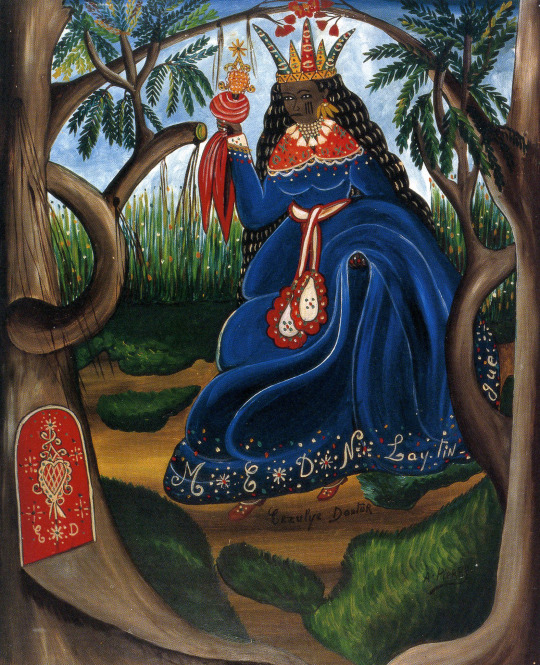
Pictured: The protective mother, “Erzulie Dantor” by Andre Pierre
In Haitian Vodou, Ezili is sometimes referred to as “Manman” (as in, “Ezili bel Manman”, “Manman cherie” “Manman lavi” etc...) This is especially true for the protective mother Manman Ezili Danto. Words of praise for Ezili (especially, “Manman Danto”) sometimes refer to her as “Manman Ou”; there are many examples of this that can easily be found on the internet.
Just a hypothesis, but “Mama You” might be derived from “Manman Ou”, or part of a sentence that goes “Mama, You…” where “Mama” refers to (Mama) Ezili. In other words, “Mama You” might not be the name of a spirit but words of praise for Ezili - possibly, but not necessarily Ezili Danto.
In Lapriye Ginen, there is a lwa called “Manman Wou”, who is part of the Ezili famille. Another possibility is that "Mama You" is derived from this "Manman Wou".
SOURCE: Beauvoir, Max. Lapriyè Ginen. Haiti, Edisyon Près Nasyonal d'Ayiti, 2008.
Benjamin Hebblewaithe reproduced Beauvoir’s list of lwa here: http://ufdcimages.uflib.ufl.edu/AA/00/02/68/96/00001/Historical%20Linguistic%20Dimensions%20of%20Spirit%20Migration%20in%20Haitian%20Vodou.pdf
This is nothing definitive; I could have this wrong.
***
Previously, I proposed a theory that the Saint-Domingans may have brought a version of Erzulie who was both Erzulie Freda and Erzulie Dantor, like so:
“While I previously argued that this must be Erzulie Freda Dahomey, I have since realized that my logic was not entirely consistent. In Haitian Vodou, there exists a massive pantheon, where the lwa can be categorized by famille . “Erzulie” is actually a famille of lwa , where Erzulie Dantor is often described as the Petwo counterpart to Erzulie Freda Dahomey. (others categorize Erzulie Dantor as Rada and Erzulie Freda Dahomey as Danwonmen ) In the historical record of New Orleans, there is no evidence of an organization of Voudou spirits by famille . Petwo counterparts to Rada lwa - such as Damballah la Flambeau, Erzulie Dantor, and Maitre Carrefour - are absent.
Papa Lébat (Louisiana Voudou) might capture an earlier version of Papa Legba (Haitian Vodou), where he is both Atibon Legba and Maitre Carrefour. If Erzulie really was incorporated into Louisiana Voudou, it is possible she was both Erzulie Freda Dahomey and Erzulie Dantor.”
Upon reflection, I realize this theory doesn’t actually make sense.
The emergence of Erzulie Dantor can be dated to Bwa Kayiman. The Saint-Domingans fled to New Orleans years after this event. It is very unlikely that Erzulie Dantor would have merged with Erzulie Freda during this time window.
Because the historical record is so sparse, there is a lot of uncertainty here. But it seems more sensible that the Saint-Domingans would have brought something resembling Azili and possibly Erzulie Freda Dahomey, if they brought a version of Erzulie with them at all. In other words, my previous speculation that this version of Erzulie would be both Erzulie Freda and Erzulie Dantor is probably wrong.
4 notes
·
View notes
Text
6 décembre : la mémoire du siège de Dubrovnik
Cette journée est connue sous le nom de Journée des défenseurs de Dubrovnik (Dan branitelja Dubrovnika) et sa célébration est liée au long siège de Dubrovnik lors de l'éclatement de la Yougoslavie.
Le siège de Dubrovnik avait débuté le 1er octobre 1991 lorsque les unités de l'Armée populaire yougoslave lancèrent une attaque contre la ville. Le siège dura jusqu'au 31 mai 1992. Le conflit rappelle celui que vit l’Ukraine aujourd’hui. Belgrade n’avait pas accepté que la Croatie fasse sécession et a lancé contre elle, l’Armée yougoslave, une armée essentiellement composée de Serbes puisque Slovènes, Croates et Bosniaques l’avaient quitté. Ces forces commanditées par l’ultra nationaliste serbe Slobodan Milosevic ont bombardé les principales villes croates pour tenter d’empêcher l’éclatement de la Yougoslavie communiste, avec la même fureur que Poutine a tenté de prendre Kiev ou Karkiv en 2022, en souvenir de la défunte URSS.
Une centaine de civils sont morts pendant le siège de Dubrovnik, 70 % des bâtiments de la vieille ville (classée au patrimoine mondial de l'UNESCO) furent endommagés. La journée du 6 décembre 1991 fut particulièrement meurtrière, c’est pour cela qu’elle fut choisie pour honorer la mémoire des anciens combattants et des victimes de l’agression de Belgrade.
Chaque année, du 3 au 7 décembre, la ville organise tout un programme de commémorations dont la partie centrale a lieu le 6 décembre. La journée commence à 8h au cimetière de Boninovo, avec un hommage aux anciens combattants tombés au combat, en particulier les pompiers, les policiers… À 11h15, c’est un récital d'enfants du primaire à l'amphithéâtre Srđ et, à 12h, un dépôt de fleurs avec allumage de bougies au pied de la croix de Srđ (la montagne qui domine la ville). À 13h, dans le port de la vieille ville, on rend hommage aux marins et vétérans tués en mer. À 15h30, les officiels se rendent au Mémorial des martyrs de Sustjepan, dans le cimetière de ce village côtier situé au nord de Dubrovnik. À 15h45, une messe est dite dans l’église de St. Nikola de Sustjepan. À 17h, retour à Dubrovnik pour le défilé de la fanfare de la ville sur le vieux port, le Stradun et devant l'église Saint-Pierre. À 18h, dans la cathédrale de Dubrovnik, c’est la traditionnelle messe solennelle à la mémoire de tous les anciens combattants tombés au combat. La soirée se termine par des concerts : à 20h, sur le Stradun, la célèbre rue centrale de la vieille ville, Đani Stipanićev & Klapa More & Klapa Ragusavecchia et, à 21h, Marko Perković, dit Thompson, le célèbre chanteur de la mouvance nationaliste croate. Le maire de Dubrovnik, Mato Franković (HDZ, droite) a toutefois interdit d’arborer les symboles du mouvement oustachi (fasciste) lors de cette journée du 6 décembre.
Un article de l'Almanach international des éditions BiblioMonde, 5 décembre 2024
1 note
·
View note
Text

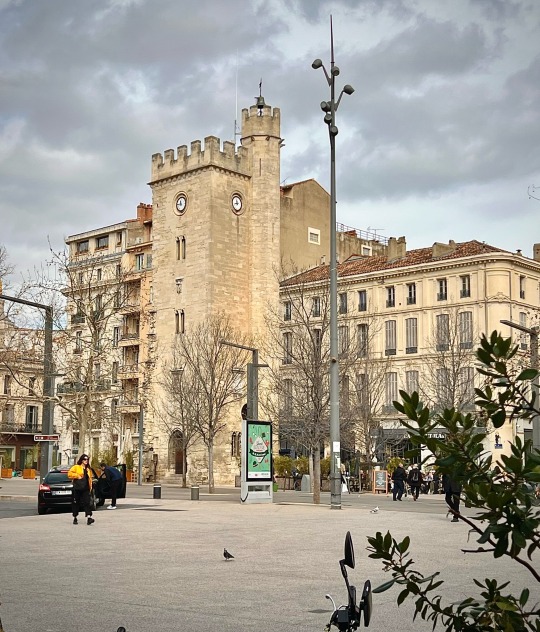
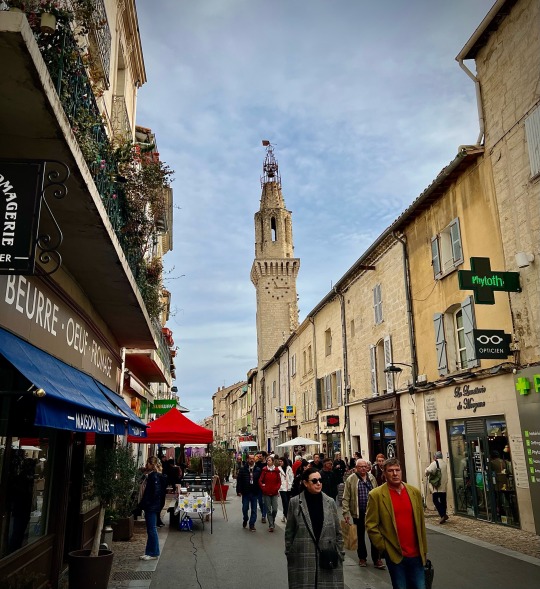
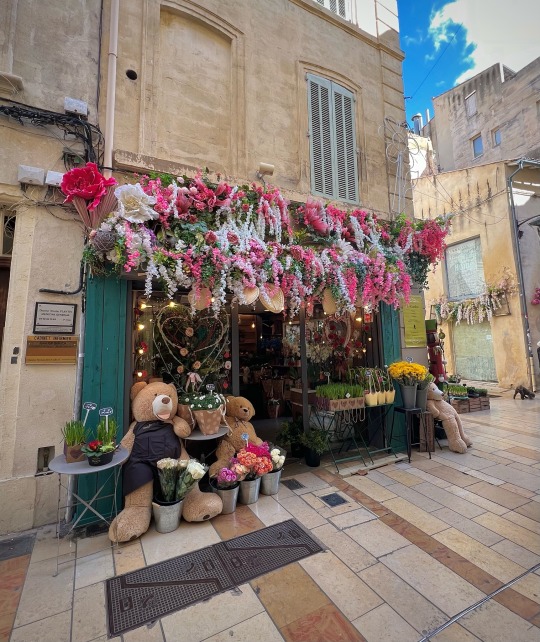
Avignon, rue Carreterie, clocher de l’église St Augustin Le clocher de l’église des Grands Augustins, surmonté d’un très ancien campanile en fer forgé, est resté légèrement penché à la suite du tremblement de terre du 11 juin 1909.Coirateria, Curateria dit l’acte de 1371 en vertu duquel on transféra dans cette rue et sur la place des Carmes le marché aux cuirs qui se tenait auparavant dans la rue des Fourbisseurs et aux alentours de l’église de Notre-Dame-La-Principale. On ignore les motifs qui le firent transférer dans la suite à la rue de la Bonneterie, où nous le trouvons établi dès le XVe siècle.
En tête de la rue de la Carreterie étaient, au nord l’hôpital des Pèlerins fondé sur la fin du XIVe siècle, et au midi le couvent des Ermites Augustins fondé en 1261.
Tour Saint-Jean - Avignon Jean-Perrin Parpaille, dit Perrinet d’Avignon, chevalier de l’Ordre du Pape, a été soupçonné de vouloir livrer la ville d’Avignon aux Calvinistes. Il fut alors arrêté à Bourg-St-Andéol à son retour de Lyon, où il était allé vendre l’argenterie des églises d’Orange. Il avait rejoint en 1561 le parti protestant et en devient l’un des chefs dans le Valentinois. Conduit à Avignon, déclaré hérétique, il fut alors décapité le 15 août 1562. Sa maison fut rasée et on en fit « la Place Pie », ainsi nommée en hommage au pape Pie IV, alors régnant.Sur ce terrain fut édifiée une halle couverte et des baraquements en bois pour loger les bêtes apportant les provisions au marché. On enterra jean-Perrin Parpaille dans l’église de Saint-Pierre d’Avignon, où l’on voit encore le mausolée familial : le rétable de Perrinet.La livrée (avec la Tour), construite au XVIème siècle se situait sur la partie nord de l’actuelle place Pie et format une séparation avec le quartier juif. Elle fut occupée par plusieurs cardinaux dont Pierre Corsini, cardinal de Florence.La Tour, dite de Saint-Jean-le-Vieux (portant le nom du pape Pie V) est le seul vestige restant de cette Livrée qui fut démolie à la fin du XIXème siècle sur une décision de la municipalité. La tour avait été restaurée en 1860 et on lui ajouta une horloge.
Église Saint-Didier - Avignon Située au centre de la ville, elle a pris la place d’une vieille église que la tradition hagiographique faisait remonter au VIIe siècle avec Agricol d’Avignon comme fondateur . Ce fut le cardinal Bertrand de Deaux qui, dans son testament, imposa à ses héritiers de faire construire sur sa succession une église. Cette clause fut avalisée par Innocent VI le 22 novembre 1355. Il a déjà réalisé l’abside de la chapelle Notre-Dame-des-Miracles à partir de 1326, travaillé sur la collégiale de Villeneuve-lès-Avignon en 1333. Il a élevé la tour de Trouillas au Palais des Papes en 1339. En 1340, il supervise l’élévation de murailles du cloître du Palais-Vieux. Il est actif jusqu’en 13663.
L’église a été construite en trois ans et quatre mois et consacrée le 20 septembre 1359. En l’état, cet édifice est considéré comme le plus caractéristique du gothique avignonnais
#original photographers#photography#photographe#photographers on tumblr#photo#france#tourism#francephotography#tourisme#avignon
6 notes
·
View notes
Text
Your Distant Voice - Christmas is comming [1/25]
Vendredi 1er Décembre 2023 ~
[6 de trefle] [Alors que vous êtes perdu dans les dédales de cette ville gigantesque que vous ne connaissez pas encore, vous demandez votre chemin. Cette personne (PNJ a créer) vous fait étrangement penser à votre Être, pourquoi ? Faites-vous connaissance ?]
Je sors de la gare de Strasbourg en tirant derrière moi mon énorme valise, ravie mais épuisée d'être enfin arrivée à destination. Forcément, après avoir traversé la France de long en large en un peu plus de 6 heures, mon smartphone est complètement déchargé. Lorsque j’ai vu la jauge de la batterie passer la barre fatidique des 10 %, j’avais tout de même eu le bon réflexe de prendre des notes rapides pour rejoindre ma destination : l’adresse, la ligne de transport à prendre, la direction et… il faudra improviser pour le reste, le téléphone s’étant éteint avant que je puisse tout noter. Super. Je m'appelle Alice et je suis perdue.
Heureusement, grâce aux plans dans la gare et en interrogeant un agent d’entretien, je parviens à trouver la bonne sortie, puis la rue et, enfin, l'arrêt du bus. En montant à l’intérieur, et puisqu’il me faut acheter un ticket, j’en profite pour demander à la conductrice si elle a une idée d’où descendre pour aller à l'adresse de mon point de chute.
C’est mon jour de chance ! Sam (c’est son nom) connaît bien le secteur. Et comme le bus est bondé, week-end d’ouverture du marché de Noël oblige, la conductrice m’invite à rester près du siège conducteur pour m'assurer que je ne loupe pas l’arrêt. Avec sa voix pétillante et son sourire malicieux, Sam semble avoir un don pour transformer chaque interaction en un moment convivial. Elle plaisante avec les passagers, lance des clins d’œil rassurants aux touristes perdus, et même le brouhaha d’un bus bondé paraît plus léger en sa présence.
Elle profite du trajet pour désigner les coins sympas devant lesquels on passe, me faire admirer les ornements festifs et me régaler d’anecdotes. Visiblement, Sam est une excellente ambassadrice de sa ville. Tandis qu’elle continue de désigner les vitrines et guirlandes lumineuses, un souvenir remonte à mon esprit. Ce n’est pas la première fois qu’un guide improvisé m’a ouvert les portes d’un nouveau monde.
Je me rappelle Erwan, lorsqu’il m’avait fait visiter le château de Comper (le centre de l’imaginaire Arthurien). Tout du long, impossible d’écouter le guide : dès qu’il parlait, Erwan se sentait irrésistiblement obligé de corriger ses explications en chuchotant, et de commenter la qualité de ses descriptions avec une moue peu convaincue. Nous avions fini tous les deux bien en retrait du cheptel resté chasse gardée du guide (qui nous avait probablement volontairement distancés pour ne plus subir la concurrence). Avec le champ désormais libre, Erwan m’avait entraînée dans sa propre version de la visite : un voyage enchanté où chaque tableau abritait un korrigan, et chaque nouvelle salle devenait le prétexte de conter une nouvelle légende. J’étais complètement tombée sous le charme. Je me souvenais d’avoir beaucoup ri et appris ce jour-là. Je me souvenais aussi de ses yeux verts pleins d'étoiles.
Et c’est ce que je revivais, douce-amère, au côté de Sam ce soir.
L’arrêt, perdu entre des arbres nus et des pavillons modestes, se trouvait deux stations avant le terminus. Comme promis, Sam m’y fit descendre avec un grand sourire, me donna des instructions détaillées pour rejoindre la rue St Nicolas, et repartit après m’avoir souhaité bon courage pour mon emménagement (et encore une fois bienvenue dans sa ville).
Tandis que le bus disparaissait dans le flot des voitures, je regardai la rue St Nicolas devant moi. Une petite église de pierre grise au coin de la rue laissa ses cloches sonner vingt heures. Malgré la fatigue, je me sentais portée par l’énergie chaleureuse de cette rencontre. Je souris en me promettant de garder cette première soirée à Strasbourg précieusement en mémoire.
---------------------------------
Your Distant Voice est un jeu de rôle en solitaire par Kaefer et Yumekaze dans lequel on raconte une histoire d’amour où souvenirs du passé, réflexions et reconstruction au présent s’entremêlent jusqu’au dénouement inéluctable. Consultez sa page itch.io par ici. Soyez sympa, donnez-lui 5 étoiles et le succès qu’il mérite !
Souvenirs du passé, péripéties du présent, nouvelles rencontres et dénouement de l’histoire sont générés par un tirage de cartes. A ma charge ensuite de jouer l’événement, raconter ce qu’il s’est passé en ajoutant des détails, des personnages, des descriptions ou même des dialogues.
#calendrier de l'avent#defi d'ecriture#ecriture#jdr#jdr solo#christmas is coming#advent calendar#creative writing#french
0 notes
Text
When the Paris Olympics nursery was announced (the first in the history of the Games) Alysia Montaño, former pro runner, Olympian, and founder of the advocacy organization &mother said “[this] is going to be really huge.” Montaño would know. She drew worldwide attention in 2014 when she ran the Outdoor USA Championships at 34 weeks pregnant, then made headlines again in 2019 when she publicly shared that Nike stopped paying her when she decided to have a baby (and how pregnant athletes could lose health insurance from the U.S. Olympic Committee if they were unable to race). Other mother runners like Kara Goucher and Allyson Felix joined her in breaking their non-disclosure agreements to share just how hard it was for sponsored athletes to start a family, prompting major contract changes and new maternity policies throughout the industry. Experts In This Article Alysia Montaño, founder of the advocacy organization &mother, former pro runner, and Olympian Kristy Baumann, RDN Neely Spence Gracey, professional long-distance runner, run coach, head of running at Guava Family, and former stroller mile world record holder Stephanie Howe, PhD, professional trail runner But five years later, the running world looks very different. “Now, every race I go to, there's a ton of fast mother runners there.”—Neely Spence Gracey “Now, every race I go to, there's a ton of fast mother runners there,” says former pro Neely Spence Gracey, who is now head of running at Guava Family. One of the most notable today is Elle Purrier St. Pierre. After New Balance stood behind her throughout pregnancy and recovery, earlier this year she broke American records in both the indoor mile and the 3,000 meters right around her son’s first birthday, then went on to make the Olympic team in the 1500 and 5,000 meters. She was joined in Paris by fellow new mom Marisa Howard, who competed in the steeplechase. Then there’s Sara Vaughn, who was offered her first substantial pro contract in 2022 at age 35, as a mom of four. When she had her first child 17 years ago, she says sponsors “saw it as a liability,” and she firmly believes motherhood held her career back. But today, Puma has fully embraced her identity as a mom in the two years since they signed her, shooting commercials showing off family life and underwriting travel costs for all four kids to attend Vaughn’s races. Meanwhile, with support from &mother, USA Track & Field (USATF) national championships have started to offer free onsite childcare for athletes. “I remember we weren't allowed to bring our kids to the warm-up area, just as a blanket rule—now they have childcare in the warm-up area!” Vaughn says. Additionally, USATF recently expanded healthcare coverage for postpartum athletes. This shift in the industry is trickling down to everyday runners, too. Last year, the Boston Marathon started allowing pregnancy and postpartum deferrals (the only deferrals that the prestigious race allows). Thanks to the work of &mother, several big events like the New York City Marathon have added lactation tents on the course in the past two years so that nursing moms can participate without harming their milk supply. One of them is this November’s Every Woman’s Marathon (the first American marathon designed for women), which also put out a whole postpartum training plan with advice specifically for new moms, and is partnering with NAPS to offer workshops for runners on how to balance parenting and training. And on a small scale, &mother set an example this year by offering childcare grants for all runners participating in its community MomForward5K. It’s not just races making changes. In 2019, there was an entire protocol developed by physical therapists on how to return to running safely after giving birth that’s now used by hundreds of new moms, both pro and amateur. And for moms whose shoe size changes during pregnancy, Felix’s running shoe brand Saysh has started offering maternity returns. Giving
moms this kind of support isn’t just about allowing them to get the mental and physical benefits of running (even though that’s plenty important in its own right). But it could foster healthy habits in their kids, too. A 2014 study in the journal Pediatrics showed that the activity levels of mothers is directly associated with the activity levels of their preschool-aged children. By making running more accessible for mothers, multiple generations benefit. Why is this happening now? After brave pros like Montaño lit a fire in 2019, many runners have been working to keep the flame burning. “People are talking [on social media] about their experiences of what they've had to go through, advocating for themselves,” says Kristy Baumann, RD, a registered dietitian who specializes in running and is working with Every Woman’s Marathon. “Until you're running while you're pregnant or postpartum, you don't really know [what you] have to go through.” Others, like Gracey, are leading by example and embracing their identities as both mothers and runners. Although she quit running professionally to spend more time with her kids, Gracey set a world record in the stroller mile last year. “The whole point of it was to create engagement and inspiration for other moms to be able to pursue their goals and to show that you can still run and pursue your passions while having kids,” she says. (Her record has since been broken, so she’s now figuring out the next distance she wants to attempt with the stroller.) This kind of visibility is part of a positive feedback loop: Montaño points out that as athletes feel more supported in their family-planning choices, they’ve become more open about sharing their identities as moms, which has made brands see the storytelling possibilities of parent athletes. Case in point: After St. Pierre’s record-breaking mile, much of the mainstream coverage highlighted the age of her son. There’s also simply more women running today, creating pressure to get what they need to participate. “I don't think suddenly the races were like, ‘We're doing this to support women,’” says professional trail runner Stephanie Howe, PhD, who’s been involved in projects at the Pro Trail Runners Association that fight for better maternity policies. ”I think it's been more women are into [running] and wanting to have these things at the races.” She points out that women are the fastest-growing demographic in trail running in particular, but they still make up only a third of the field. “If we want to keep leveling up, we want to make it accessible for women,” she says. “And this is a huge, huge part of it because your competitive years are also your childbearing years.” Where the running world still falls short for mother runners Of course, there remains plenty of room for improvement. For starters, a lack of accessible childcare is a major hurdle. “The number one thing that keeps me from racing right now is I don't have anything to do with [my son unless] I can get a babysitter to travel with me,” says Howe, a single mom, who says she’d happily pay for childcare options if they were available. Montaño points to USA Cycling, which offers a small stipend for childcare, as a potential example to follow at the pro level. “When we sign these contracts, it's like any business, right? There's budget for physio. There's budget for travel. And I would love to see a budget for childcare,” she says. Gracey and Howe both wish for better access to postpartum pelvic floor physical therapy. Instead of runners waiting until they’re dealing with prolapse, “it would be so helpful if it was just the norm that everyone got a chance to have pelvic floor therapy to get that one-on-one help to be able to fully heal and recover in those critical weeks following delivery,” Gracey says. “That would help prevent a lot of longer-term issues.” The good news is that change is happening, and many leaders in the space are receptive to it. Baumann, who has been working with
&mother to ask more race directors for lactation accommodations, says, “Overall, people are understanding and willing to listen and just have to figure out the logistics.” Montaño hopes that changes made in the running space will have an impact beyond sports, too. “You see families fighting for paid leave, access to affordable childcare, safe and respectful lactation accommodations across all industries,” she says. “We're using sports as our podium moment to do this across society.” Well+Good articles reference scientific, reliable, recent, robust studies to back up the information we share. You can trust us along your wellness journey. Hesketh, Kathryn R et al. “Activity levels in mothers and their preschool children.” Pediatrics vol. 133,4 (2014): e973-80. doi:10.1542/peds.2013-3153
0 notes